Principles and Practice of Marketing: BMW UK Case Study
VerifiedAdded on 2023/06/13
|22
|5190
|129
AI Summary
This case study focuses on the branding and international marketing strategy of BMW UK. It discusses the effectiveness of BMW's current branding strategy based on Aaker and Keller's theories of brand equity. It also explores BMW's international marketing strategy and the implications for marketing mix. The study includes a brief description of BMW, its marketing strategy, marketing mix, financial and marketplace performance. The subject is Principles and Practice of Marketing and the course code is not mentioned. The college/university is not mentioned.
Contribute Materials
Your contribution can guide someone’s learning journey. Share your
documents today.
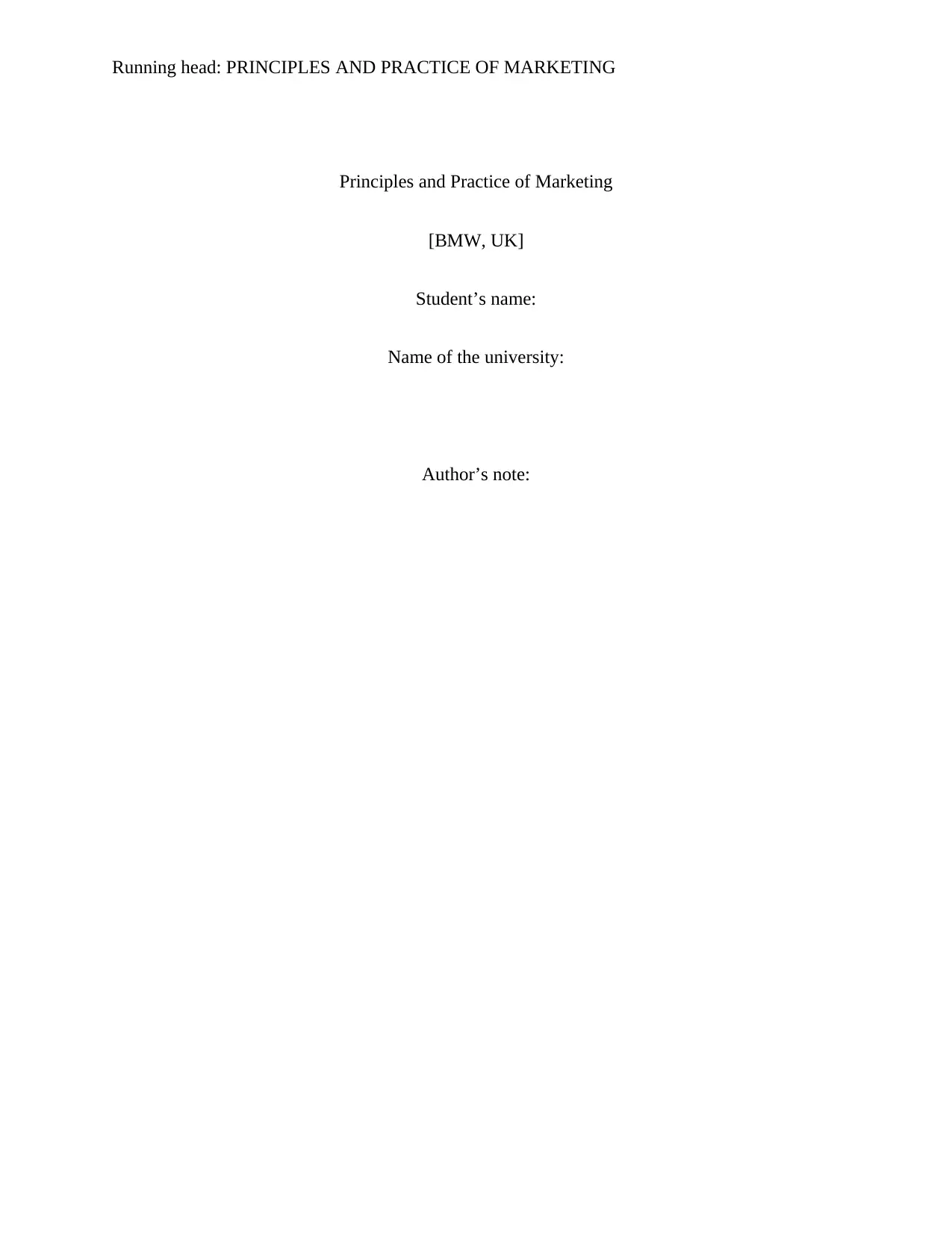
Running head: PRINCIPLES AND PRACTICE OF MARKETING
Principles and Practice of Marketing
[BMW, UK]
Student’s name:
Name of the university:
Author’s note:
Principles and Practice of Marketing
[BMW, UK]
Student’s name:
Name of the university:
Author’s note:
Secure Best Marks with AI Grader
Need help grading? Try our AI Grader for instant feedback on your assignments.
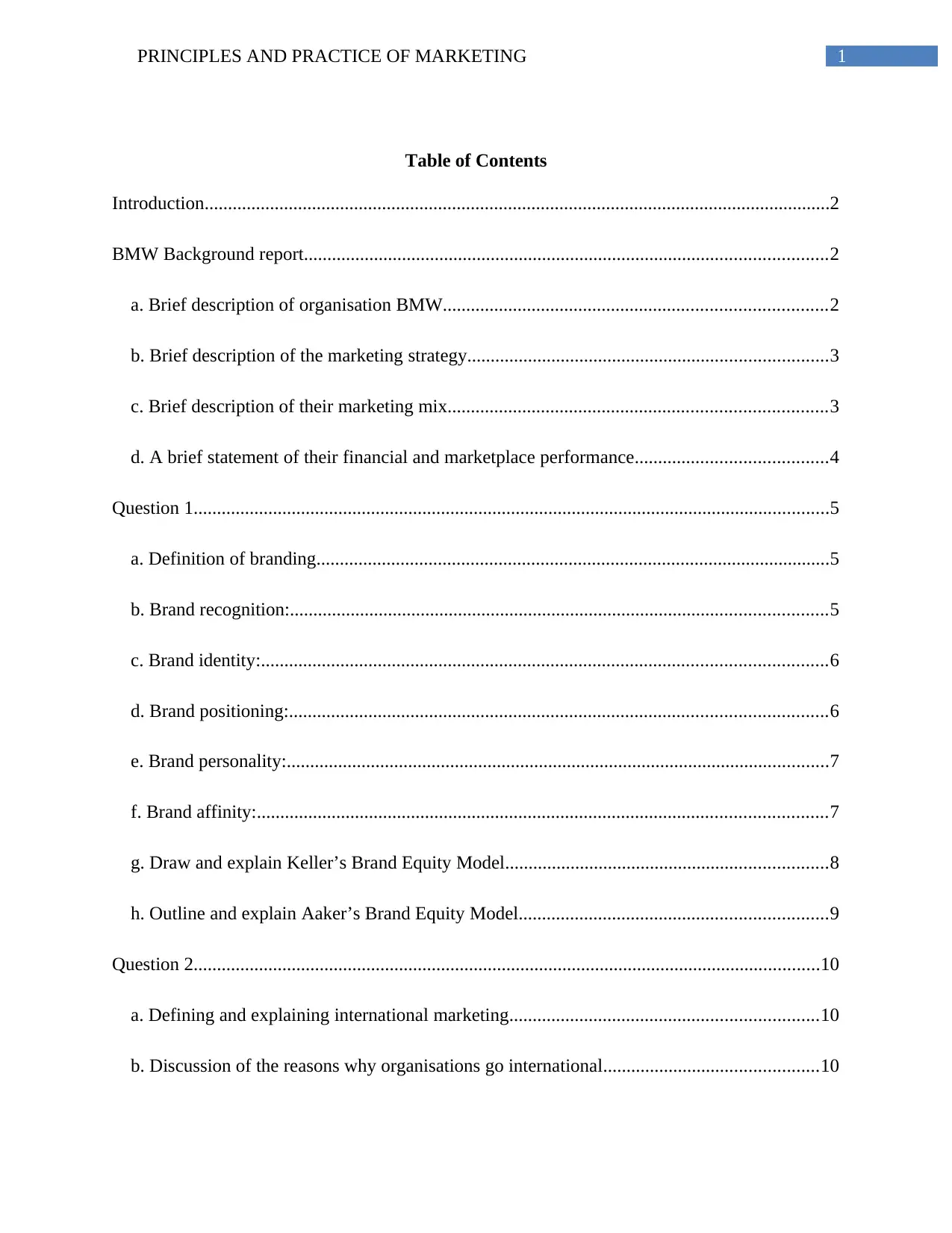
1PRINCIPLES AND PRACTICE OF MARKETING
Table of Contents
Introduction......................................................................................................................................2
BMW Background report................................................................................................................2
a. Brief description of organisation BMW..................................................................................2
b. Brief description of the marketing strategy.............................................................................3
c. Brief description of their marketing mix.................................................................................3
d. A brief statement of their financial and marketplace performance.........................................4
Question 1........................................................................................................................................5
a. Definition of branding..............................................................................................................5
b. Brand recognition:...................................................................................................................5
c. Brand identity:.........................................................................................................................6
d. Brand positioning:...................................................................................................................6
e. Brand personality:....................................................................................................................7
f. Brand affinity:..........................................................................................................................7
g. Draw and explain Keller’s Brand Equity Model.....................................................................8
h. Outline and explain Aaker’s Brand Equity Model..................................................................9
Question 2......................................................................................................................................10
a. Defining and explaining international marketing..................................................................10
b. Discussion of the reasons why organisations go international..............................................10
Table of Contents
Introduction......................................................................................................................................2
BMW Background report................................................................................................................2
a. Brief description of organisation BMW..................................................................................2
b. Brief description of the marketing strategy.............................................................................3
c. Brief description of their marketing mix.................................................................................3
d. A brief statement of their financial and marketplace performance.........................................4
Question 1........................................................................................................................................5
a. Definition of branding..............................................................................................................5
b. Brand recognition:...................................................................................................................5
c. Brand identity:.........................................................................................................................6
d. Brand positioning:...................................................................................................................6
e. Brand personality:....................................................................................................................7
f. Brand affinity:..........................................................................................................................7
g. Draw and explain Keller’s Brand Equity Model.....................................................................8
h. Outline and explain Aaker’s Brand Equity Model..................................................................9
Question 2......................................................................................................................................10
a. Defining and explaining international marketing..................................................................10
b. Discussion of the reasons why organisations go international..............................................10
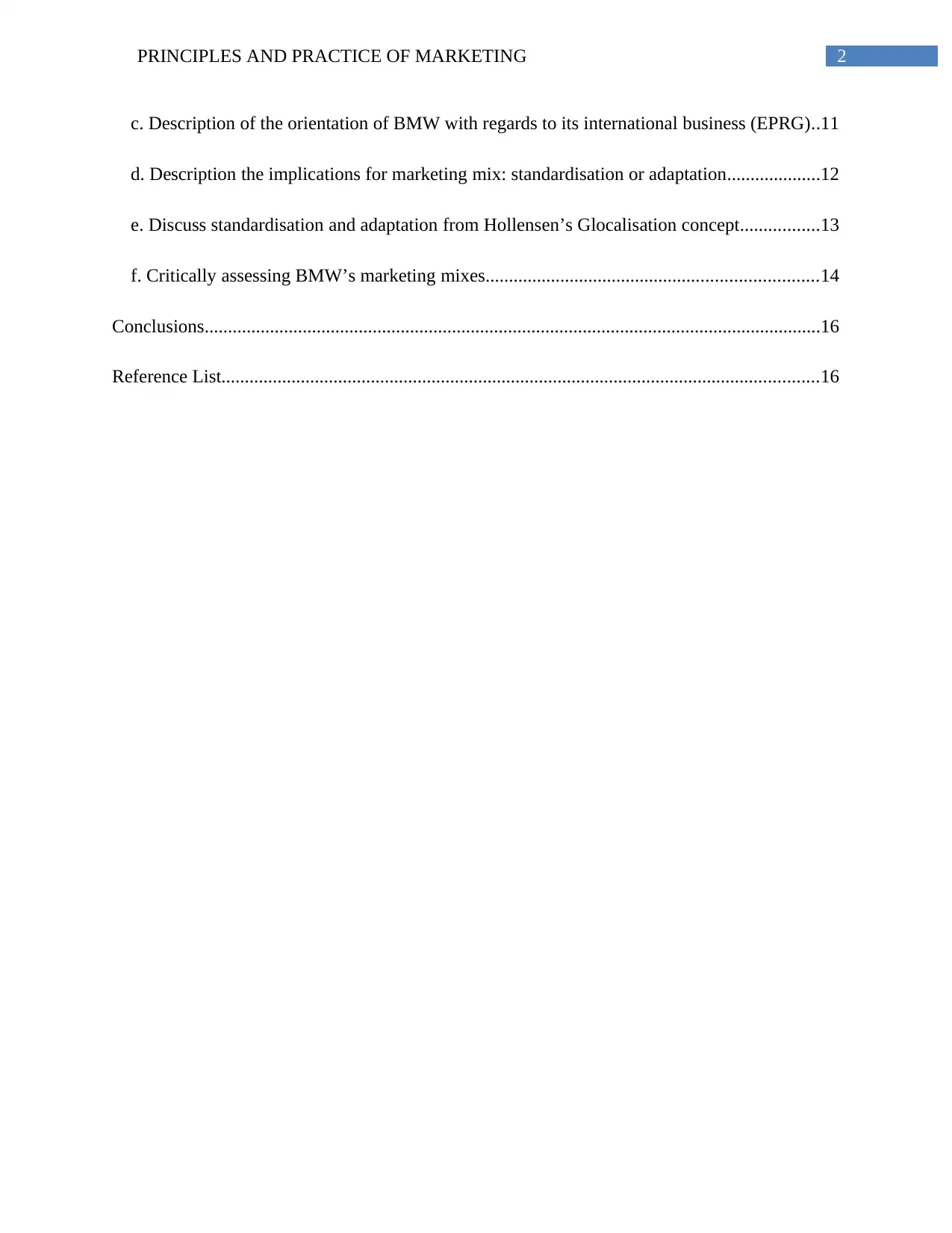
2PRINCIPLES AND PRACTICE OF MARKETING
c. Description of the orientation of BMW with regards to its international business (EPRG)..11
d. Description the implications for marketing mix: standardisation or adaptation....................12
e. Discuss standardisation and adaptation from Hollensen’s Glocalisation concept.................13
f. Critically assessing BMW’s marketing mixes.......................................................................14
Conclusions....................................................................................................................................16
Reference List................................................................................................................................16
c. Description of the orientation of BMW with regards to its international business (EPRG)..11
d. Description the implications for marketing mix: standardisation or adaptation....................12
e. Discuss standardisation and adaptation from Hollensen’s Glocalisation concept.................13
f. Critically assessing BMW’s marketing mixes.......................................................................14
Conclusions....................................................................................................................................16
Reference List................................................................................................................................16
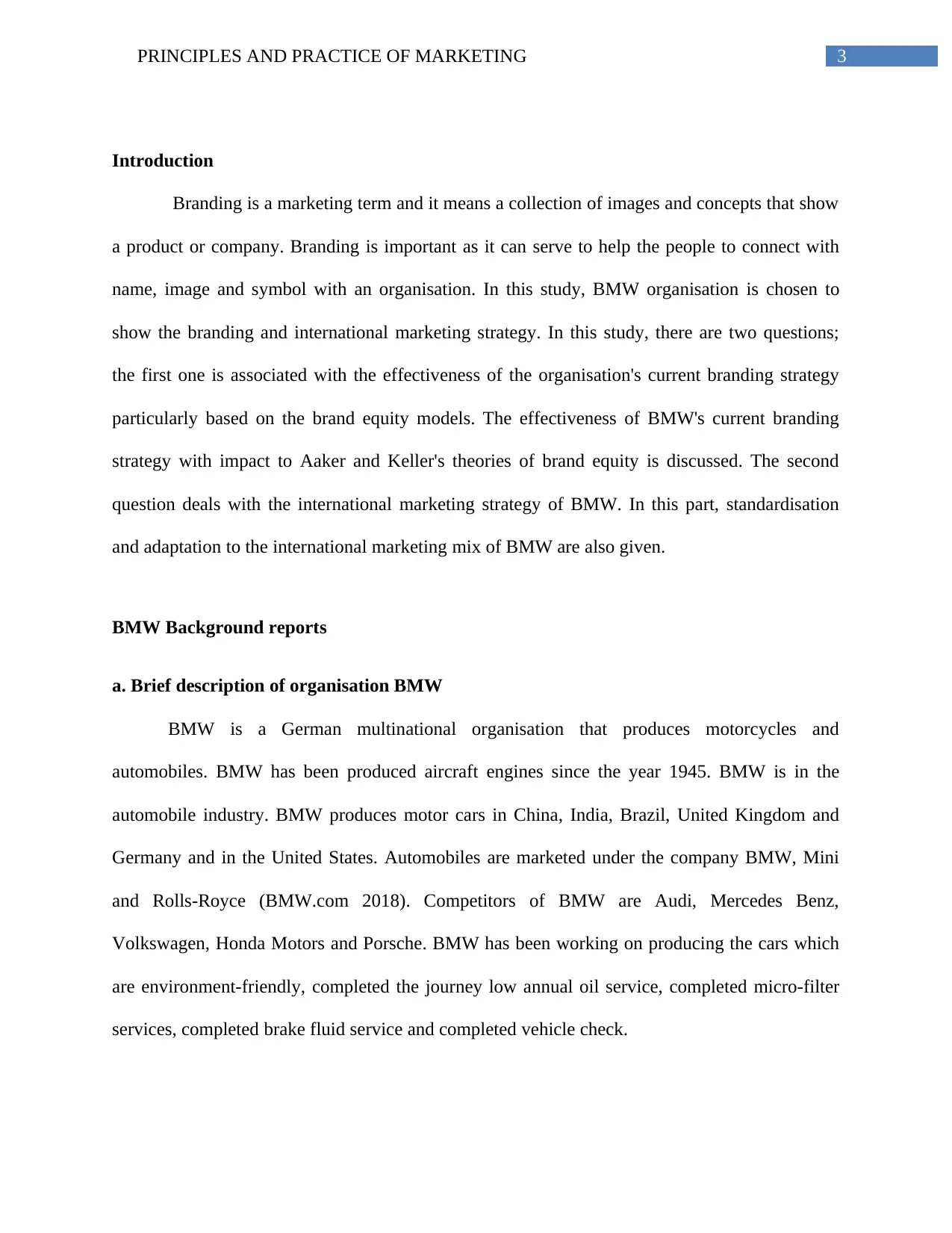
3PRINCIPLES AND PRACTICE OF MARKETING
Introduction
Branding is a marketing term and it means a collection of images and concepts that show
a product or company. Branding is important as it can serve to help the people to connect with
name, image and symbol with an organisation. In this study, BMW organisation is chosen to
show the branding and international marketing strategy. In this study, there are two questions;
the first one is associated with the effectiveness of the organisation's current branding strategy
particularly based on the brand equity models. The effectiveness of BMW's current branding
strategy with impact to Aaker and Keller's theories of brand equity is discussed. The second
question deals with the international marketing strategy of BMW. In this part, standardisation
and adaptation to the international marketing mix of BMW are also given.
BMW Background reports
a. Brief description of organisation BMW
BMW is a German multinational organisation that produces motorcycles and
automobiles. BMW has been produced aircraft engines since the year 1945. BMW is in the
automobile industry. BMW produces motor cars in China, India, Brazil, United Kingdom and
Germany and in the United States. Automobiles are marketed under the company BMW, Mini
and Rolls-Royce (BMW.com 2018). Competitors of BMW are Audi, Mercedes Benz,
Volkswagen, Honda Motors and Porsche. BMW has been working on producing the cars which
are environment-friendly, completed the journey low annual oil service, completed micro-filter
services, completed brake fluid service and completed vehicle check.
Introduction
Branding is a marketing term and it means a collection of images and concepts that show
a product or company. Branding is important as it can serve to help the people to connect with
name, image and symbol with an organisation. In this study, BMW organisation is chosen to
show the branding and international marketing strategy. In this study, there are two questions;
the first one is associated with the effectiveness of the organisation's current branding strategy
particularly based on the brand equity models. The effectiveness of BMW's current branding
strategy with impact to Aaker and Keller's theories of brand equity is discussed. The second
question deals with the international marketing strategy of BMW. In this part, standardisation
and adaptation to the international marketing mix of BMW are also given.
BMW Background reports
a. Brief description of organisation BMW
BMW is a German multinational organisation that produces motorcycles and
automobiles. BMW has been produced aircraft engines since the year 1945. BMW is in the
automobile industry. BMW produces motor cars in China, India, Brazil, United Kingdom and
Germany and in the United States. Automobiles are marketed under the company BMW, Mini
and Rolls-Royce (BMW.com 2018). Competitors of BMW are Audi, Mercedes Benz,
Volkswagen, Honda Motors and Porsche. BMW has been working on producing the cars which
are environment-friendly, completed the journey low annual oil service, completed micro-filter
services, completed brake fluid service and completed vehicle check.
Secure Best Marks with AI Grader
Need help grading? Try our AI Grader for instant feedback on your assignments.
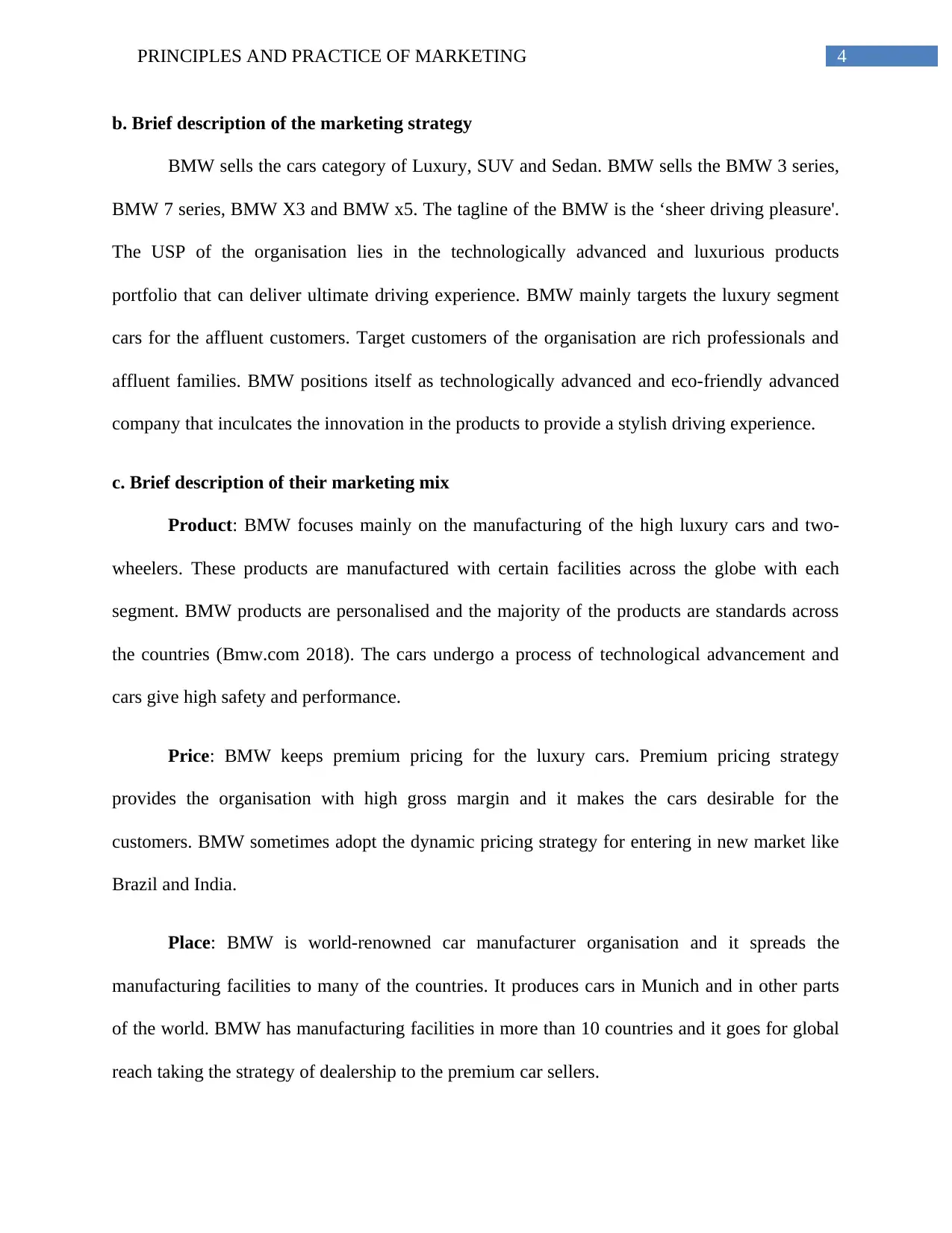
4PRINCIPLES AND PRACTICE OF MARKETING
b. Brief description of the marketing strategy
BMW sells the cars category of Luxury, SUV and Sedan. BMW sells the BMW 3 series,
BMW 7 series, BMW X3 and BMW x5. The tagline of the BMW is the ‘sheer driving pleasure'.
The USP of the organisation lies in the technologically advanced and luxurious products
portfolio that can deliver ultimate driving experience. BMW mainly targets the luxury segment
cars for the affluent customers. Target customers of the organisation are rich professionals and
affluent families. BMW positions itself as technologically advanced and eco-friendly advanced
company that inculcates the innovation in the products to provide a stylish driving experience.
c. Brief description of their marketing mix
Product: BMW focuses mainly on the manufacturing of the high luxury cars and two-
wheelers. These products are manufactured with certain facilities across the globe with each
segment. BMW products are personalised and the majority of the products are standards across
the countries (Bmw.com 2018). The cars undergo a process of technological advancement and
cars give high safety and performance.
Price: BMW keeps premium pricing for the luxury cars. Premium pricing strategy
provides the organisation with high gross margin and it makes the cars desirable for the
customers. BMW sometimes adopt the dynamic pricing strategy for entering in new market like
Brazil and India.
Place: BMW is world-renowned car manufacturer organisation and it spreads the
manufacturing facilities to many of the countries. It produces cars in Munich and in other parts
of the world. BMW has manufacturing facilities in more than 10 countries and it goes for global
reach taking the strategy of dealership to the premium car sellers.
b. Brief description of the marketing strategy
BMW sells the cars category of Luxury, SUV and Sedan. BMW sells the BMW 3 series,
BMW 7 series, BMW X3 and BMW x5. The tagline of the BMW is the ‘sheer driving pleasure'.
The USP of the organisation lies in the technologically advanced and luxurious products
portfolio that can deliver ultimate driving experience. BMW mainly targets the luxury segment
cars for the affluent customers. Target customers of the organisation are rich professionals and
affluent families. BMW positions itself as technologically advanced and eco-friendly advanced
company that inculcates the innovation in the products to provide a stylish driving experience.
c. Brief description of their marketing mix
Product: BMW focuses mainly on the manufacturing of the high luxury cars and two-
wheelers. These products are manufactured with certain facilities across the globe with each
segment. BMW products are personalised and the majority of the products are standards across
the countries (Bmw.com 2018). The cars undergo a process of technological advancement and
cars give high safety and performance.
Price: BMW keeps premium pricing for the luxury cars. Premium pricing strategy
provides the organisation with high gross margin and it makes the cars desirable for the
customers. BMW sometimes adopt the dynamic pricing strategy for entering in new market like
Brazil and India.
Place: BMW is world-renowned car manufacturer organisation and it spreads the
manufacturing facilities to many of the countries. It produces cars in Munich and in other parts
of the world. BMW has manufacturing facilities in more than 10 countries and it goes for global
reach taking the strategy of dealership to the premium car sellers.
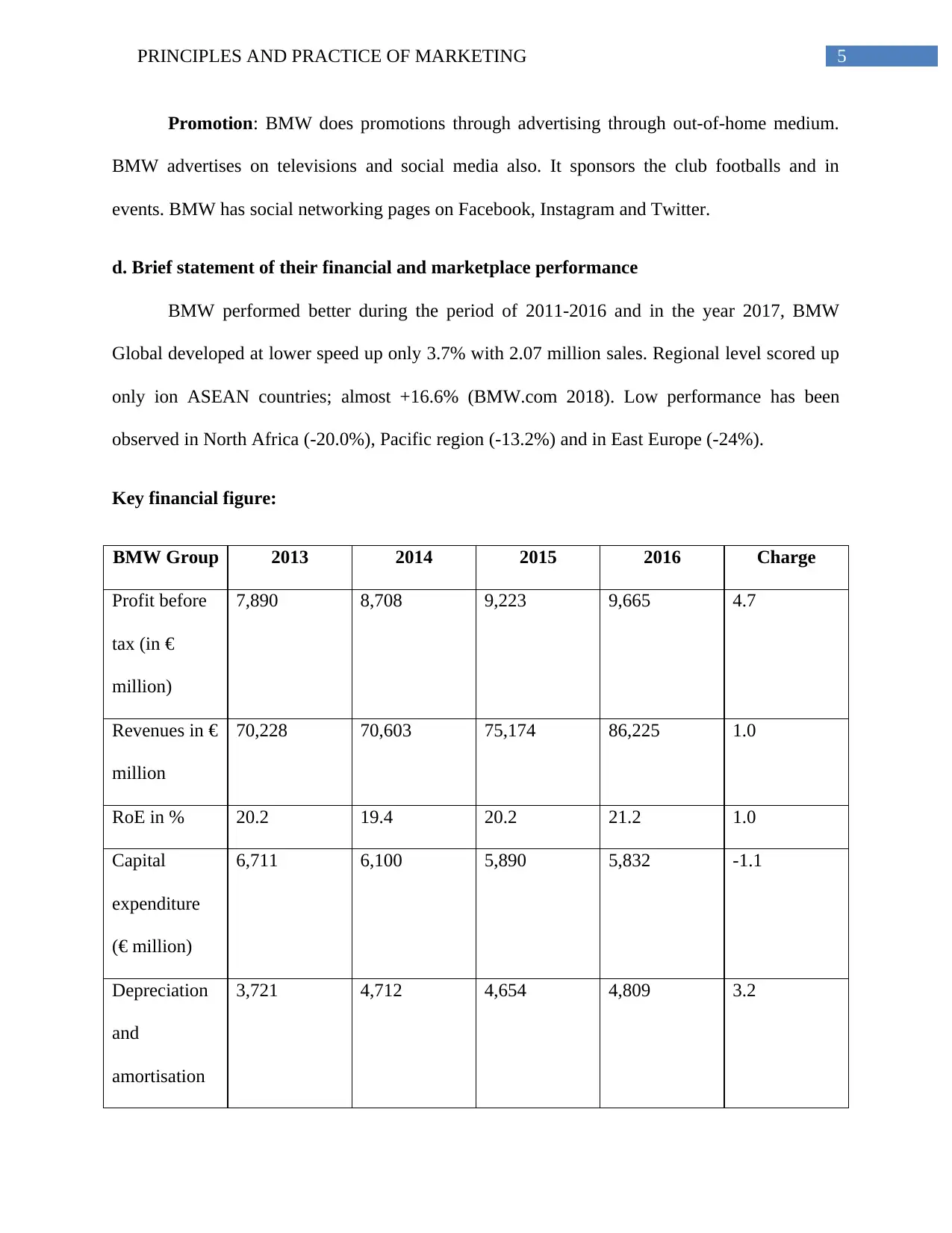
5PRINCIPLES AND PRACTICE OF MARKETING
Promotion: BMW does promotions through advertising through out-of-home medium.
BMW advertises on televisions and social media also. It sponsors the club footballs and in
events. BMW has social networking pages on Facebook, Instagram and Twitter.
d. Brief statement of their financial and marketplace performance
BMW performed better during the period of 2011-2016 and in the year 2017, BMW
Global developed at lower speed up only 3.7% with 2.07 million sales. Regional level scored up
only ion ASEAN countries; almost +16.6% (BMW.com 2018). Low performance has been
observed in North Africa (-20.0%), Pacific region (-13.2%) and in East Europe (-24%).
Key financial figure:
BMW Group 2013 2014 2015 2016 Charge
Profit before
tax (in €
million)
7,890 8,708 9,223 9,665 4.7
Revenues in €
million
70,228 70,603 75,174 86,225 1.0
RoE in % 20.2 19.4 20.2 21.2 1.0
Capital
expenditure
(€ million)
6,711 6,100 5,890 5,832 -1.1
Depreciation
and
amortisation
3,721 4,712 4,654 4,809 3.2
Promotion: BMW does promotions through advertising through out-of-home medium.
BMW advertises on televisions and social media also. It sponsors the club footballs and in
events. BMW has social networking pages on Facebook, Instagram and Twitter.
d. Brief statement of their financial and marketplace performance
BMW performed better during the period of 2011-2016 and in the year 2017, BMW
Global developed at lower speed up only 3.7% with 2.07 million sales. Regional level scored up
only ion ASEAN countries; almost +16.6% (BMW.com 2018). Low performance has been
observed in North Africa (-20.0%), Pacific region (-13.2%) and in East Europe (-24%).
Key financial figure:
BMW Group 2013 2014 2015 2016 Charge
Profit before
tax (in €
million)
7,890 8,708 9,223 9,665 4.7
Revenues in €
million
70,228 70,603 75,174 86,225 1.0
RoE in % 20.2 19.4 20.2 21.2 1.0
Capital
expenditure
(€ million)
6,711 6,100 5,890 5,832 -1.1
Depreciation
and
amortisation
3,721 4,712 4,654 4,809 3.2
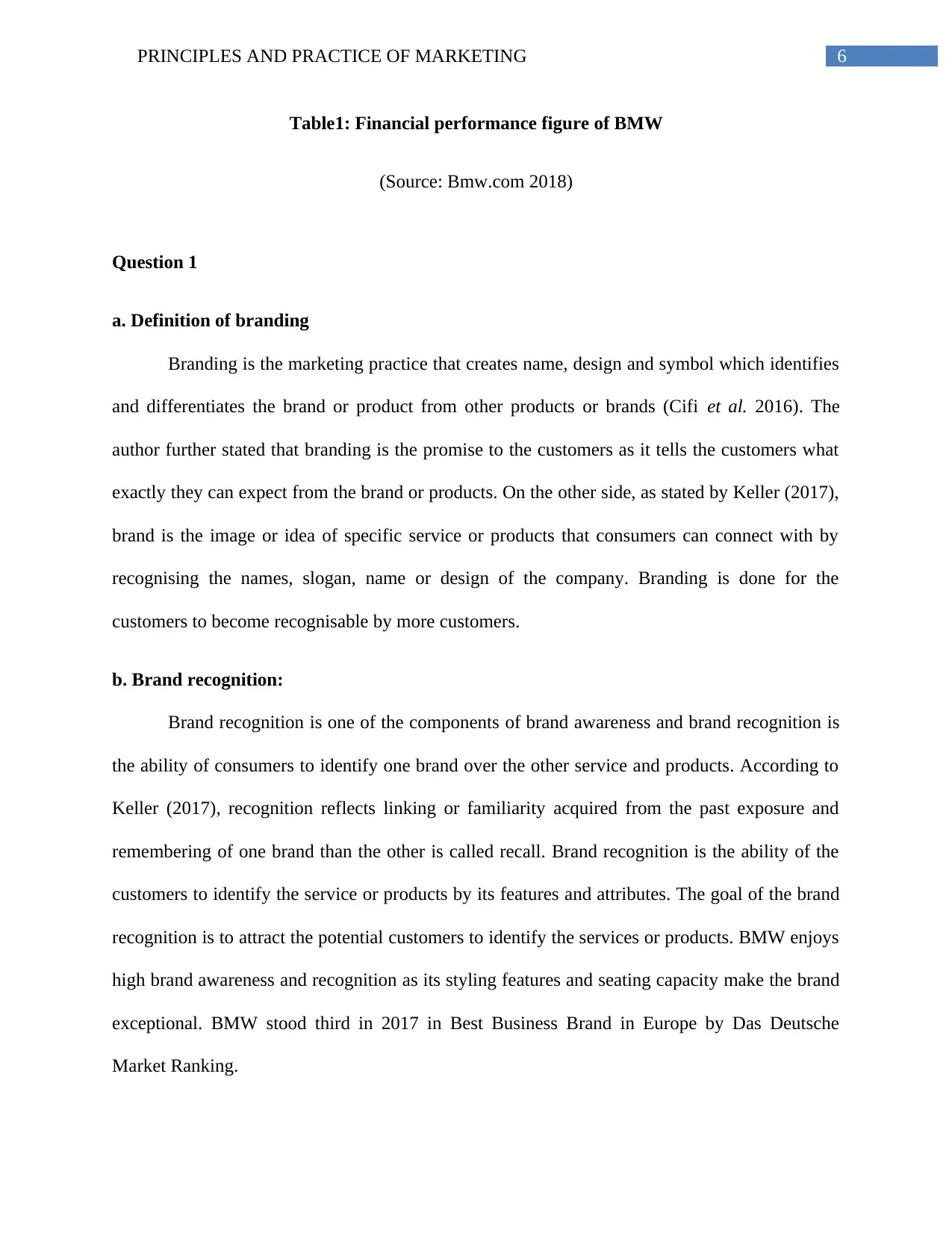
6PRINCIPLES AND PRACTICE OF MARKETING
Table1: Financial performance figure of BMW
(Source: Bmw.com 2018)
Question 1
a. Definition of branding
Branding is the marketing practice that creates name, design and symbol which identifies
and differentiates the brand or product from other products or brands (Cifi et al. 2016). The
author further stated that branding is the promise to the customers as it tells the customers what
exactly they can expect from the brand or products. On the other side, as stated by Keller (2017),
brand is the image or idea of specific service or products that consumers can connect with by
recognising the names, slogan, name or design of the company. Branding is done for the
customers to become recognisable by more customers.
b. Brand recognition:
Brand recognition is one of the components of brand awareness and brand recognition is
the ability of consumers to identify one brand over the other service and products. According to
Keller (2017), recognition reflects linking or familiarity acquired from the past exposure and
remembering of one brand than the other is called recall. Brand recognition is the ability of the
customers to identify the service or products by its features and attributes. The goal of the brand
recognition is to attract the potential customers to identify the services or products. BMW enjoys
high brand awareness and recognition as its styling features and seating capacity make the brand
exceptional. BMW stood third in 2017 in Best Business Brand in Europe by Das Deutsche
Market Ranking.
Table1: Financial performance figure of BMW
(Source: Bmw.com 2018)
Question 1
a. Definition of branding
Branding is the marketing practice that creates name, design and symbol which identifies
and differentiates the brand or product from other products or brands (Cifi et al. 2016). The
author further stated that branding is the promise to the customers as it tells the customers what
exactly they can expect from the brand or products. On the other side, as stated by Keller (2017),
brand is the image or idea of specific service or products that consumers can connect with by
recognising the names, slogan, name or design of the company. Branding is done for the
customers to become recognisable by more customers.
b. Brand recognition:
Brand recognition is one of the components of brand awareness and brand recognition is
the ability of consumers to identify one brand over the other service and products. According to
Keller (2017), recognition reflects linking or familiarity acquired from the past exposure and
remembering of one brand than the other is called recall. Brand recognition is the ability of the
customers to identify the service or products by its features and attributes. The goal of the brand
recognition is to attract the potential customers to identify the services or products. BMW enjoys
high brand awareness and recognition as its styling features and seating capacity make the brand
exceptional. BMW stood third in 2017 in Best Business Brand in Europe by Das Deutsche
Market Ranking.
Paraphrase This Document
Need a fresh take? Get an instant paraphrase of this document with our AI Paraphraser
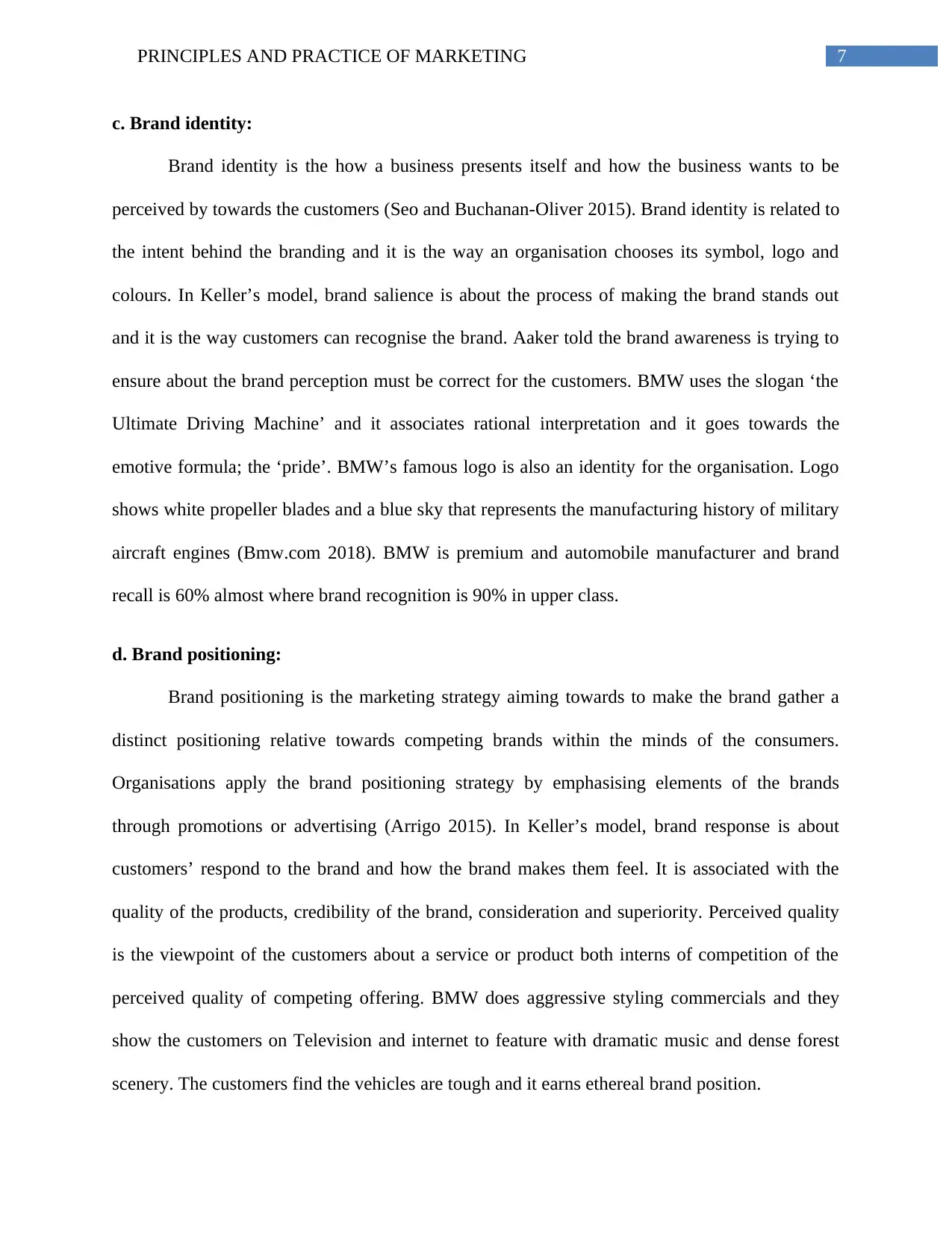
7PRINCIPLES AND PRACTICE OF MARKETING
c. Brand identity:
Brand identity is the how a business presents itself and how the business wants to be
perceived by towards the customers (Seo and Buchanan-Oliver 2015). Brand identity is related to
the intent behind the branding and it is the way an organisation chooses its symbol, logo and
colours. In Keller’s model, brand salience is about the process of making the brand stands out
and it is the way customers can recognise the brand. Aaker told the brand awareness is trying to
ensure about the brand perception must be correct for the customers. BMW uses the slogan ‘the
Ultimate Driving Machine’ and it associates rational interpretation and it goes towards the
emotive formula; the ‘pride’. BMW’s famous logo is also an identity for the organisation. Logo
shows white propeller blades and a blue sky that represents the manufacturing history of military
aircraft engines (Bmw.com 2018). BMW is premium and automobile manufacturer and brand
recall is 60% almost where brand recognition is 90% in upper class.
d. Brand positioning:
Brand positioning is the marketing strategy aiming towards to make the brand gather a
distinct positioning relative towards competing brands within the minds of the consumers.
Organisations apply the brand positioning strategy by emphasising elements of the brands
through promotions or advertising (Arrigo 2015). In Keller’s model, brand response is about
customers’ respond to the brand and how the brand makes them feel. It is associated with the
quality of the products, credibility of the brand, consideration and superiority. Perceived quality
is the viewpoint of the customers about a service or product both interns of competition of the
perceived quality of competing offering. BMW does aggressive styling commercials and they
show the customers on Television and internet to feature with dramatic music and dense forest
scenery. The customers find the vehicles are tough and it earns ethereal brand position.
c. Brand identity:
Brand identity is the how a business presents itself and how the business wants to be
perceived by towards the customers (Seo and Buchanan-Oliver 2015). Brand identity is related to
the intent behind the branding and it is the way an organisation chooses its symbol, logo and
colours. In Keller’s model, brand salience is about the process of making the brand stands out
and it is the way customers can recognise the brand. Aaker told the brand awareness is trying to
ensure about the brand perception must be correct for the customers. BMW uses the slogan ‘the
Ultimate Driving Machine’ and it associates rational interpretation and it goes towards the
emotive formula; the ‘pride’. BMW’s famous logo is also an identity for the organisation. Logo
shows white propeller blades and a blue sky that represents the manufacturing history of military
aircraft engines (Bmw.com 2018). BMW is premium and automobile manufacturer and brand
recall is 60% almost where brand recognition is 90% in upper class.
d. Brand positioning:
Brand positioning is the marketing strategy aiming towards to make the brand gather a
distinct positioning relative towards competing brands within the minds of the consumers.
Organisations apply the brand positioning strategy by emphasising elements of the brands
through promotions or advertising (Arrigo 2015). In Keller’s model, brand response is about
customers’ respond to the brand and how the brand makes them feel. It is associated with the
quality of the products, credibility of the brand, consideration and superiority. Perceived quality
is the viewpoint of the customers about a service or product both interns of competition of the
perceived quality of competing offering. BMW does aggressive styling commercials and they
show the customers on Television and internet to feature with dramatic music and dense forest
scenery. The customers find the vehicles are tough and it earns ethereal brand position.
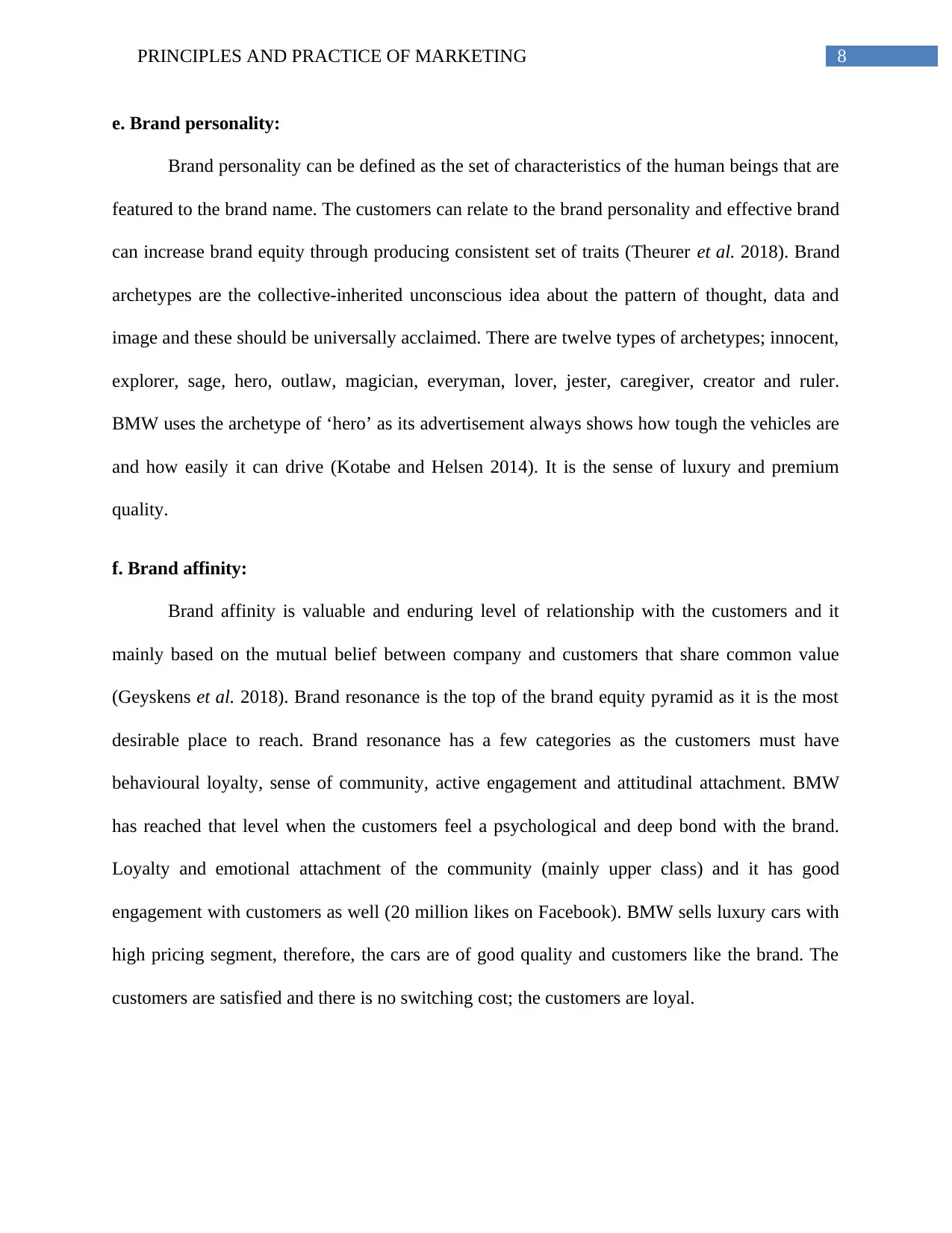
8PRINCIPLES AND PRACTICE OF MARKETING
e. Brand personality:
Brand personality can be defined as the set of characteristics of the human beings that are
featured to the brand name. The customers can relate to the brand personality and effective brand
can increase brand equity through producing consistent set of traits (Theurer et al. 2018). Brand
archetypes are the collective-inherited unconscious idea about the pattern of thought, data and
image and these should be universally acclaimed. There are twelve types of archetypes; innocent,
explorer, sage, hero, outlaw, magician, everyman, lover, jester, caregiver, creator and ruler.
BMW uses the archetype of ‘hero’ as its advertisement always shows how tough the vehicles are
and how easily it can drive (Kotabe and Helsen 2014). It is the sense of luxury and premium
quality.
f. Brand affinity:
Brand affinity is valuable and enduring level of relationship with the customers and it
mainly based on the mutual belief between company and customers that share common value
(Geyskens et al. 2018). Brand resonance is the top of the brand equity pyramid as it is the most
desirable place to reach. Brand resonance has a few categories as the customers must have
behavioural loyalty, sense of community, active engagement and attitudinal attachment. BMW
has reached that level when the customers feel a psychological and deep bond with the brand.
Loyalty and emotional attachment of the community (mainly upper class) and it has good
engagement with customers as well (20 million likes on Facebook). BMW sells luxury cars with
high pricing segment, therefore, the cars are of good quality and customers like the brand. The
customers are satisfied and there is no switching cost; the customers are loyal.
e. Brand personality:
Brand personality can be defined as the set of characteristics of the human beings that are
featured to the brand name. The customers can relate to the brand personality and effective brand
can increase brand equity through producing consistent set of traits (Theurer et al. 2018). Brand
archetypes are the collective-inherited unconscious idea about the pattern of thought, data and
image and these should be universally acclaimed. There are twelve types of archetypes; innocent,
explorer, sage, hero, outlaw, magician, everyman, lover, jester, caregiver, creator and ruler.
BMW uses the archetype of ‘hero’ as its advertisement always shows how tough the vehicles are
and how easily it can drive (Kotabe and Helsen 2014). It is the sense of luxury and premium
quality.
f. Brand affinity:
Brand affinity is valuable and enduring level of relationship with the customers and it
mainly based on the mutual belief between company and customers that share common value
(Geyskens et al. 2018). Brand resonance is the top of the brand equity pyramid as it is the most
desirable place to reach. Brand resonance has a few categories as the customers must have
behavioural loyalty, sense of community, active engagement and attitudinal attachment. BMW
has reached that level when the customers feel a psychological and deep bond with the brand.
Loyalty and emotional attachment of the community (mainly upper class) and it has good
engagement with customers as well (20 million likes on Facebook). BMW sells luxury cars with
high pricing segment, therefore, the cars are of good quality and customers like the brand. The
customers are satisfied and there is no switching cost; the customers are loyal.
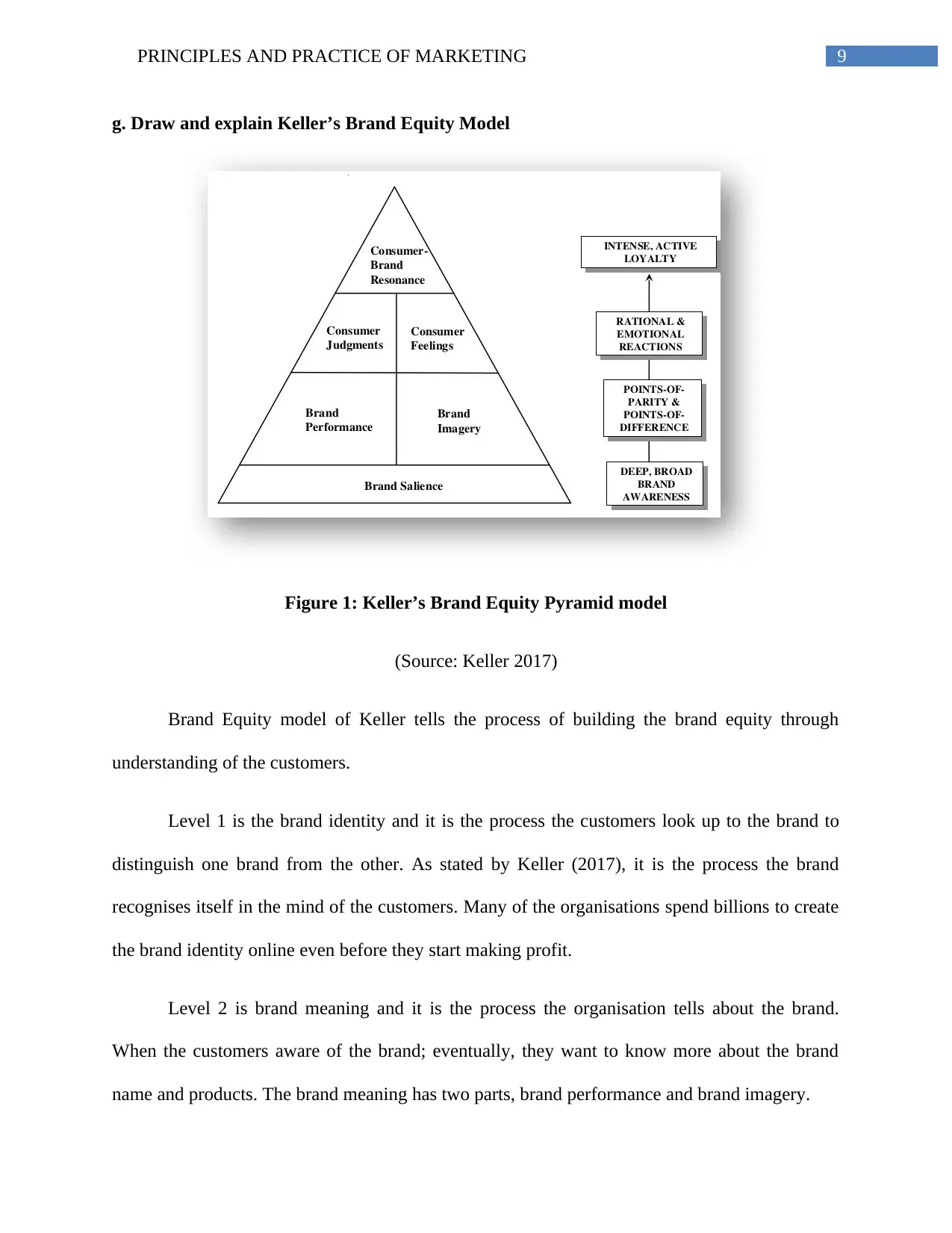
9PRINCIPLES AND PRACTICE OF MARKETING
g. Draw and explain Keller’s Brand Equity Model
Figure 1: Keller’s Brand Equity Pyramid model
(Source: Keller 2017)
Brand Equity model of Keller tells the process of building the brand equity through
understanding of the customers.
Level 1 is the brand identity and it is the process the customers look up to the brand to
distinguish one brand from the other. As stated by Keller (2017), it is the process the brand
recognises itself in the mind of the customers. Many of the organisations spend billions to create
the brand identity online even before they start making profit.
Level 2 is brand meaning and it is the process the organisation tells about the brand.
When the customers aware of the brand; eventually, they want to know more about the brand
name and products. The brand meaning has two parts, brand performance and brand imagery.
g. Draw and explain Keller’s Brand Equity Model
Figure 1: Keller’s Brand Equity Pyramid model
(Source: Keller 2017)
Brand Equity model of Keller tells the process of building the brand equity through
understanding of the customers.
Level 1 is the brand identity and it is the process the customers look up to the brand to
distinguish one brand from the other. As stated by Keller (2017), it is the process the brand
recognises itself in the mind of the customers. Many of the organisations spend billions to create
the brand identity online even before they start making profit.
Level 2 is brand meaning and it is the process the organisation tells about the brand.
When the customers aware of the brand; eventually, they want to know more about the brand
name and products. The brand meaning has two parts, brand performance and brand imagery.
Secure Best Marks with AI Grader
Need help grading? Try our AI Grader for instant feedback on your assignments.
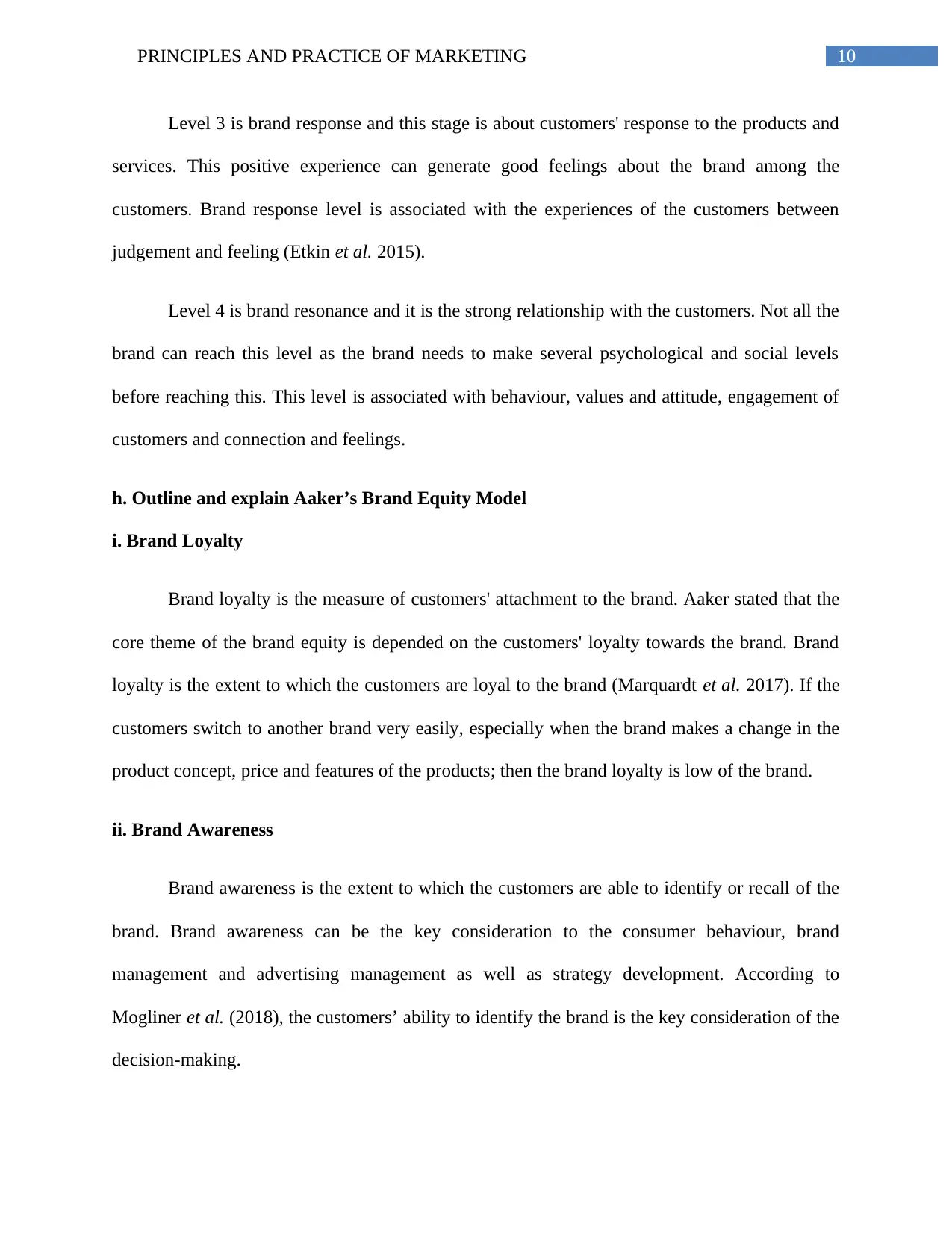
10PRINCIPLES AND PRACTICE OF MARKETING
Level 3 is brand response and this stage is about customers' response to the products and
services. This positive experience can generate good feelings about the brand among the
customers. Brand response level is associated with the experiences of the customers between
judgement and feeling (Etkin et al. 2015).
Level 4 is brand resonance and it is the strong relationship with the customers. Not all the
brand can reach this level as the brand needs to make several psychological and social levels
before reaching this. This level is associated with behaviour, values and attitude, engagement of
customers and connection and feelings.
h. Outline and explain Aaker’s Brand Equity Model
i. Brand Loyalty
Brand loyalty is the measure of customers' attachment to the brand. Aaker stated that the
core theme of the brand equity is depended on the customers' loyalty towards the brand. Brand
loyalty is the extent to which the customers are loyal to the brand (Marquardt et al. 2017). If the
customers switch to another brand very easily, especially when the brand makes a change in the
product concept, price and features of the products; then the brand loyalty is low of the brand.
ii. Brand Awareness
Brand awareness is the extent to which the customers are able to identify or recall of the
brand. Brand awareness can be the key consideration to the consumer behaviour, brand
management and advertising management as well as strategy development. According to
Mogliner et al. (2018), the customers’ ability to identify the brand is the key consideration of the
decision-making.
Level 3 is brand response and this stage is about customers' response to the products and
services. This positive experience can generate good feelings about the brand among the
customers. Brand response level is associated with the experiences of the customers between
judgement and feeling (Etkin et al. 2015).
Level 4 is brand resonance and it is the strong relationship with the customers. Not all the
brand can reach this level as the brand needs to make several psychological and social levels
before reaching this. This level is associated with behaviour, values and attitude, engagement of
customers and connection and feelings.
h. Outline and explain Aaker’s Brand Equity Model
i. Brand Loyalty
Brand loyalty is the measure of customers' attachment to the brand. Aaker stated that the
core theme of the brand equity is depended on the customers' loyalty towards the brand. Brand
loyalty is the extent to which the customers are loyal to the brand (Marquardt et al. 2017). If the
customers switch to another brand very easily, especially when the brand makes a change in the
product concept, price and features of the products; then the brand loyalty is low of the brand.
ii. Brand Awareness
Brand awareness is the extent to which the customers are able to identify or recall of the
brand. Brand awareness can be the key consideration to the consumer behaviour, brand
management and advertising management as well as strategy development. According to
Mogliner et al. (2018), the customers’ ability to identify the brand is the key consideration of the
decision-making.
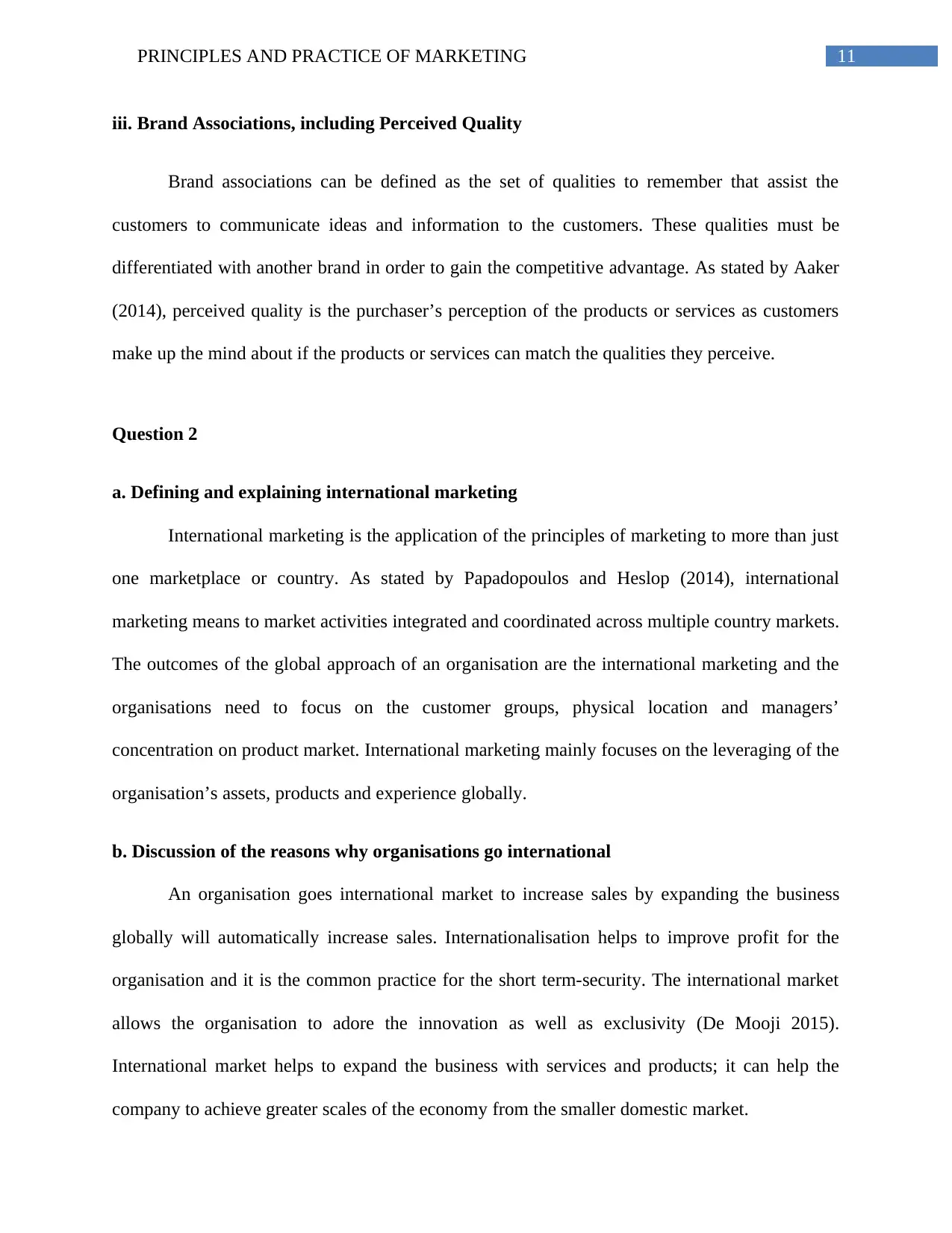
11PRINCIPLES AND PRACTICE OF MARKETING
iii. Brand Associations, including Perceived Quality
Brand associations can be defined as the set of qualities to remember that assist the
customers to communicate ideas and information to the customers. These qualities must be
differentiated with another brand in order to gain the competitive advantage. As stated by Aaker
(2014), perceived quality is the purchaser’s perception of the products or services as customers
make up the mind about if the products or services can match the qualities they perceive.
Question 2
a. Defining and explaining international marketing
International marketing is the application of the principles of marketing to more than just
one marketplace or country. As stated by Papadopoulos and Heslop (2014), international
marketing means to market activities integrated and coordinated across multiple country markets.
The outcomes of the global approach of an organisation are the international marketing and the
organisations need to focus on the customer groups, physical location and managers’
concentration on product market. International marketing mainly focuses on the leveraging of the
organisation’s assets, products and experience globally.
b. Discussion of the reasons why organisations go international
An organisation goes international market to increase sales by expanding the business
globally will automatically increase sales. Internationalisation helps to improve profit for the
organisation and it is the common practice for the short term-security. The international market
allows the organisation to adore the innovation as well as exclusivity (De Mooji 2015).
International market helps to expand the business with services and products; it can help the
company to achieve greater scales of the economy from the smaller domestic market.
iii. Brand Associations, including Perceived Quality
Brand associations can be defined as the set of qualities to remember that assist the
customers to communicate ideas and information to the customers. These qualities must be
differentiated with another brand in order to gain the competitive advantage. As stated by Aaker
(2014), perceived quality is the purchaser’s perception of the products or services as customers
make up the mind about if the products or services can match the qualities they perceive.
Question 2
a. Defining and explaining international marketing
International marketing is the application of the principles of marketing to more than just
one marketplace or country. As stated by Papadopoulos and Heslop (2014), international
marketing means to market activities integrated and coordinated across multiple country markets.
The outcomes of the global approach of an organisation are the international marketing and the
organisations need to focus on the customer groups, physical location and managers’
concentration on product market. International marketing mainly focuses on the leveraging of the
organisation’s assets, products and experience globally.
b. Discussion of the reasons why organisations go international
An organisation goes international market to increase sales by expanding the business
globally will automatically increase sales. Internationalisation helps to improve profit for the
organisation and it is the common practice for the short term-security. The international market
allows the organisation to adore the innovation as well as exclusivity (De Mooji 2015).
International market helps to expand the business with services and products; it can help the
company to achieve greater scales of the economy from the smaller domestic market.
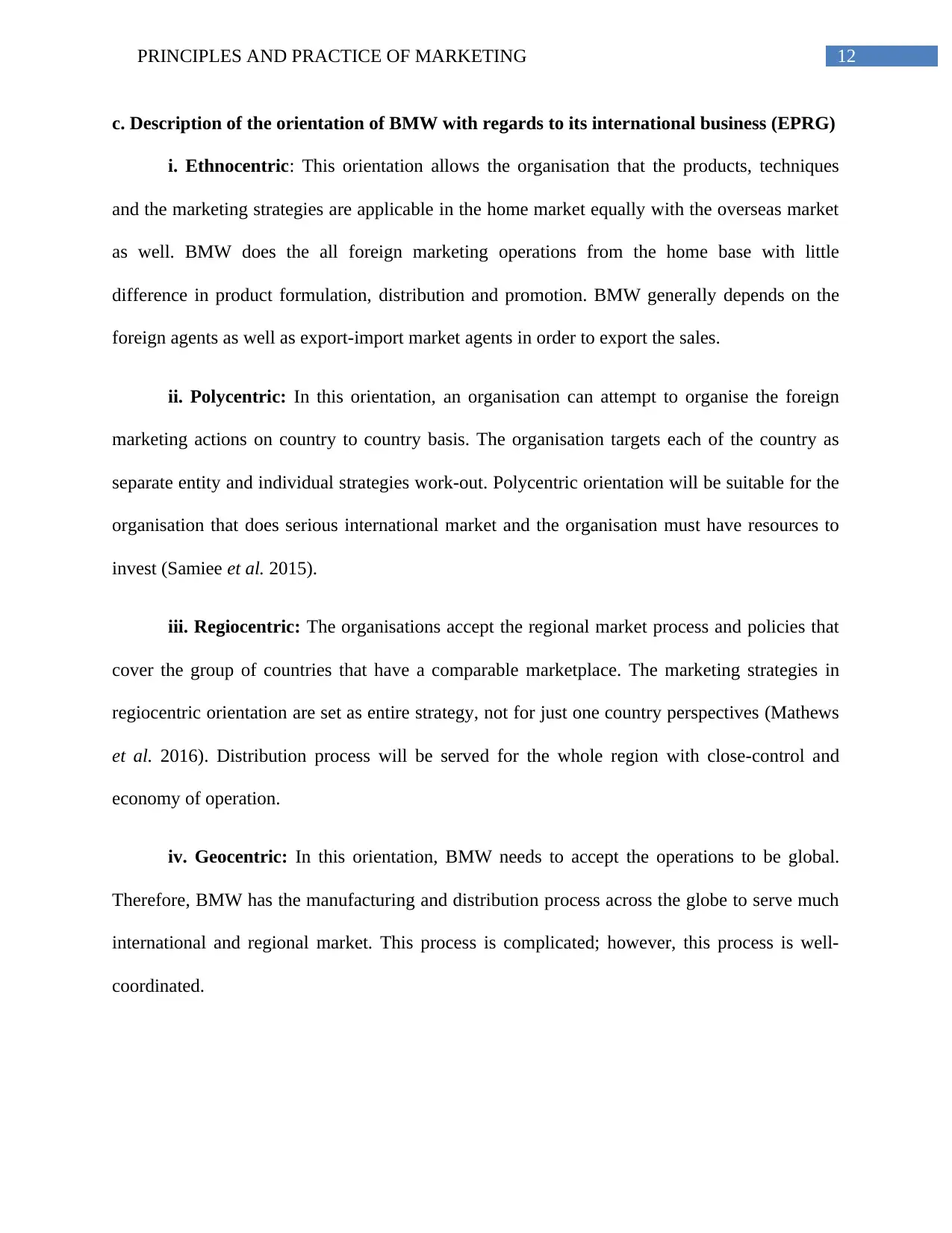
12PRINCIPLES AND PRACTICE OF MARKETING
c. Description of the orientation of BMW with regards to its international business (EPRG)
i. Ethnocentric: This orientation allows the organisation that the products, techniques
and the marketing strategies are applicable in the home market equally with the overseas market
as well. BMW does the all foreign marketing operations from the home base with little
difference in product formulation, distribution and promotion. BMW generally depends on the
foreign agents as well as export-import market agents in order to export the sales.
ii. Polycentric: In this orientation, an organisation can attempt to organise the foreign
marketing actions on country to country basis. The organisation targets each of the country as
separate entity and individual strategies work-out. Polycentric orientation will be suitable for the
organisation that does serious international market and the organisation must have resources to
invest (Samiee et al. 2015).
iii. Regiocentric: The organisations accept the regional market process and policies that
cover the group of countries that have a comparable marketplace. The marketing strategies in
regiocentric orientation are set as entire strategy, not for just one country perspectives (Mathews
et al. 2016). Distribution process will be served for the whole region with close-control and
economy of operation.
iv. Geocentric: In this orientation, BMW needs to accept the operations to be global.
Therefore, BMW has the manufacturing and distribution process across the globe to serve much
international and regional market. This process is complicated; however, this process is well-
coordinated.
c. Description of the orientation of BMW with regards to its international business (EPRG)
i. Ethnocentric: This orientation allows the organisation that the products, techniques
and the marketing strategies are applicable in the home market equally with the overseas market
as well. BMW does the all foreign marketing operations from the home base with little
difference in product formulation, distribution and promotion. BMW generally depends on the
foreign agents as well as export-import market agents in order to export the sales.
ii. Polycentric: In this orientation, an organisation can attempt to organise the foreign
marketing actions on country to country basis. The organisation targets each of the country as
separate entity and individual strategies work-out. Polycentric orientation will be suitable for the
organisation that does serious international market and the organisation must have resources to
invest (Samiee et al. 2015).
iii. Regiocentric: The organisations accept the regional market process and policies that
cover the group of countries that have a comparable marketplace. The marketing strategies in
regiocentric orientation are set as entire strategy, not for just one country perspectives (Mathews
et al. 2016). Distribution process will be served for the whole region with close-control and
economy of operation.
iv. Geocentric: In this orientation, BMW needs to accept the operations to be global.
Therefore, BMW has the manufacturing and distribution process across the globe to serve much
international and regional market. This process is complicated; however, this process is well-
coordinated.
Paraphrase This Document
Need a fresh take? Get an instant paraphrase of this document with our AI Paraphraser
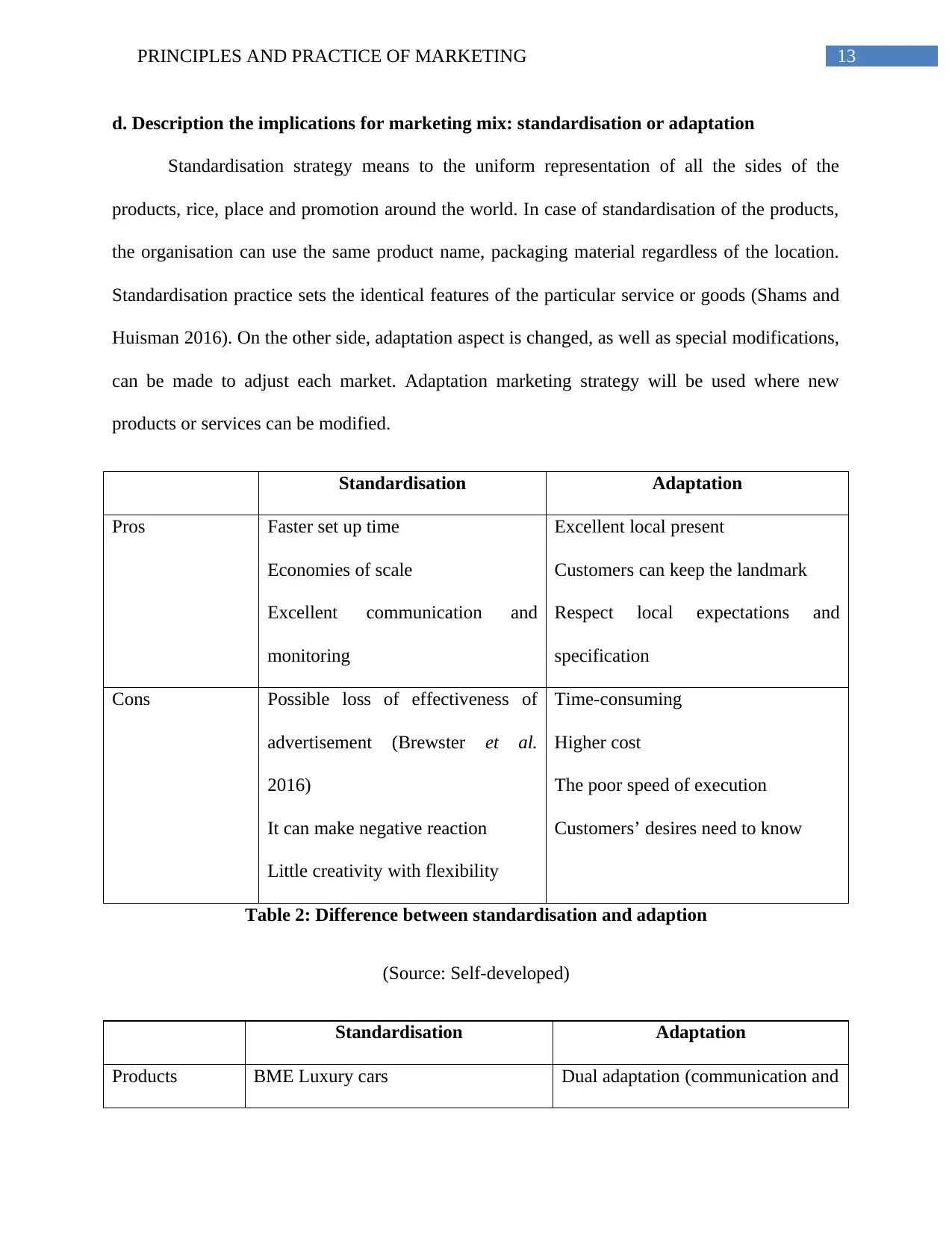
13PRINCIPLES AND PRACTICE OF MARKETING
d. Description the implications for marketing mix: standardisation or adaptation
Standardisation strategy means to the uniform representation of all the sides of the
products, rice, place and promotion around the world. In case of standardisation of the products,
the organisation can use the same product name, packaging material regardless of the location.
Standardisation practice sets the identical features of the particular service or goods (Shams and
Huisman 2016). On the other side, adaptation aspect is changed, as well as special modifications,
can be made to adjust each market. Adaptation marketing strategy will be used where new
products or services can be modified.
Standardisation Adaptation
Pros Faster set up time
Economies of scale
Excellent communication and
monitoring
Excellent local present
Customers can keep the landmark
Respect local expectations and
specification
Cons Possible loss of effectiveness of
advertisement (Brewster et al.
2016)
It can make negative reaction
Little creativity with flexibility
Time-consuming
Higher cost
The poor speed of execution
Customers’ desires need to know
Table 2: Difference between standardisation and adaption
(Source: Self-developed)
Standardisation Adaptation
Products BME Luxury cars Dual adaptation (communication and
d. Description the implications for marketing mix: standardisation or adaptation
Standardisation strategy means to the uniform representation of all the sides of the
products, rice, place and promotion around the world. In case of standardisation of the products,
the organisation can use the same product name, packaging material regardless of the location.
Standardisation practice sets the identical features of the particular service or goods (Shams and
Huisman 2016). On the other side, adaptation aspect is changed, as well as special modifications,
can be made to adjust each market. Adaptation marketing strategy will be used where new
products or services can be modified.
Standardisation Adaptation
Pros Faster set up time
Economies of scale
Excellent communication and
monitoring
Excellent local present
Customers can keep the landmark
Respect local expectations and
specification
Cons Possible loss of effectiveness of
advertisement (Brewster et al.
2016)
It can make negative reaction
Little creativity with flexibility
Time-consuming
Higher cost
The poor speed of execution
Customers’ desires need to know
Table 2: Difference between standardisation and adaption
(Source: Self-developed)
Standardisation Adaptation
Products BME Luxury cars Dual adaptation (communication and
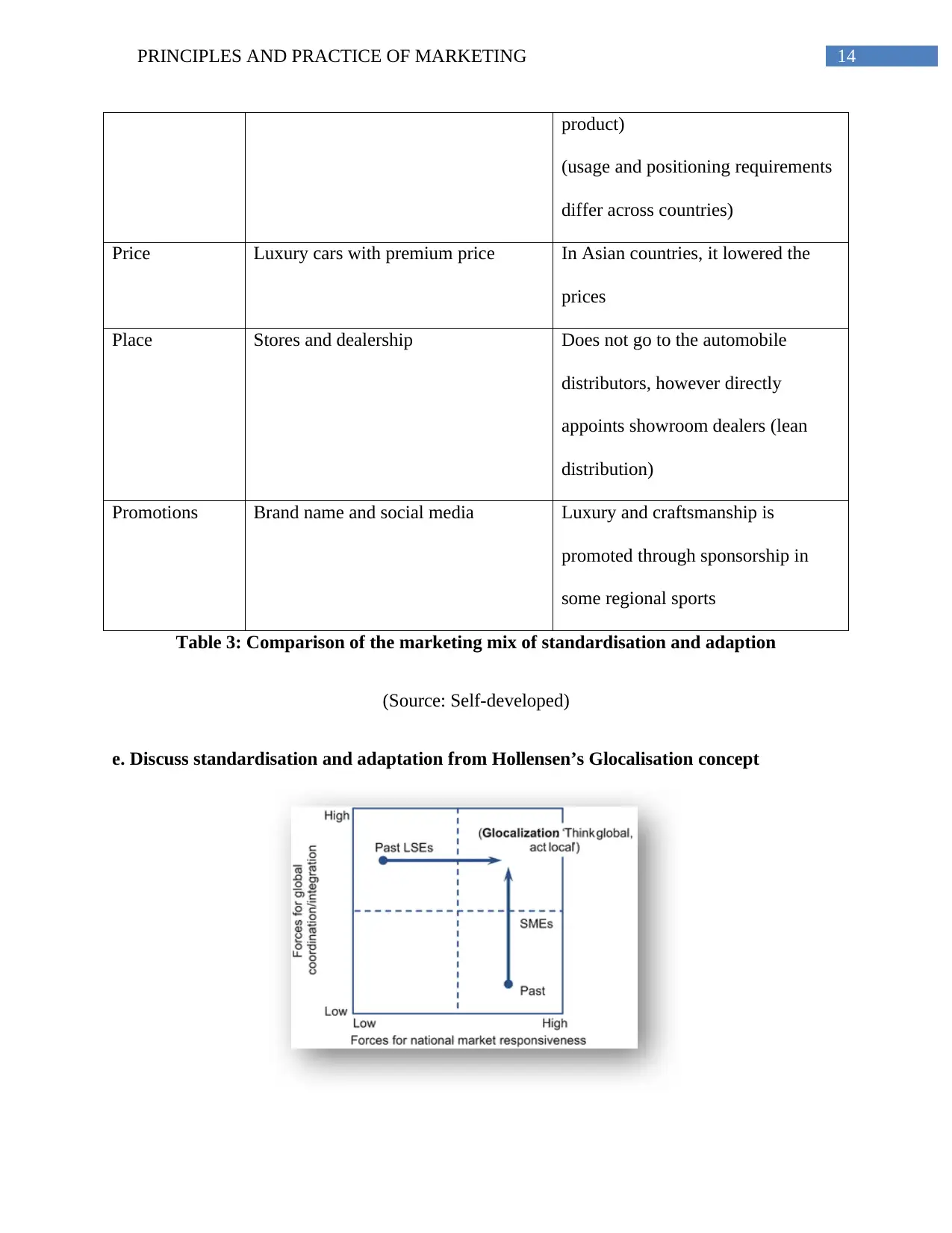
14PRINCIPLES AND PRACTICE OF MARKETING
product)
(usage and positioning requirements
differ across countries)
Price Luxury cars with premium price In Asian countries, it lowered the
prices
Place Stores and dealership Does not go to the automobile
distributors, however directly
appoints showroom dealers (lean
distribution)
Promotions Brand name and social media Luxury and craftsmanship is
promoted through sponsorship in
some regional sports
Table 3: Comparison of the marketing mix of standardisation and adaption
(Source: Self-developed)
e. Discuss standardisation and adaptation from Hollensen’s Glocalisation concept
product)
(usage and positioning requirements
differ across countries)
Price Luxury cars with premium price In Asian countries, it lowered the
prices
Place Stores and dealership Does not go to the automobile
distributors, however directly
appoints showroom dealers (lean
distribution)
Promotions Brand name and social media Luxury and craftsmanship is
promoted through sponsorship in
some regional sports
Table 3: Comparison of the marketing mix of standardisation and adaption
(Source: Self-developed)
e. Discuss standardisation and adaptation from Hollensen’s Glocalisation concept
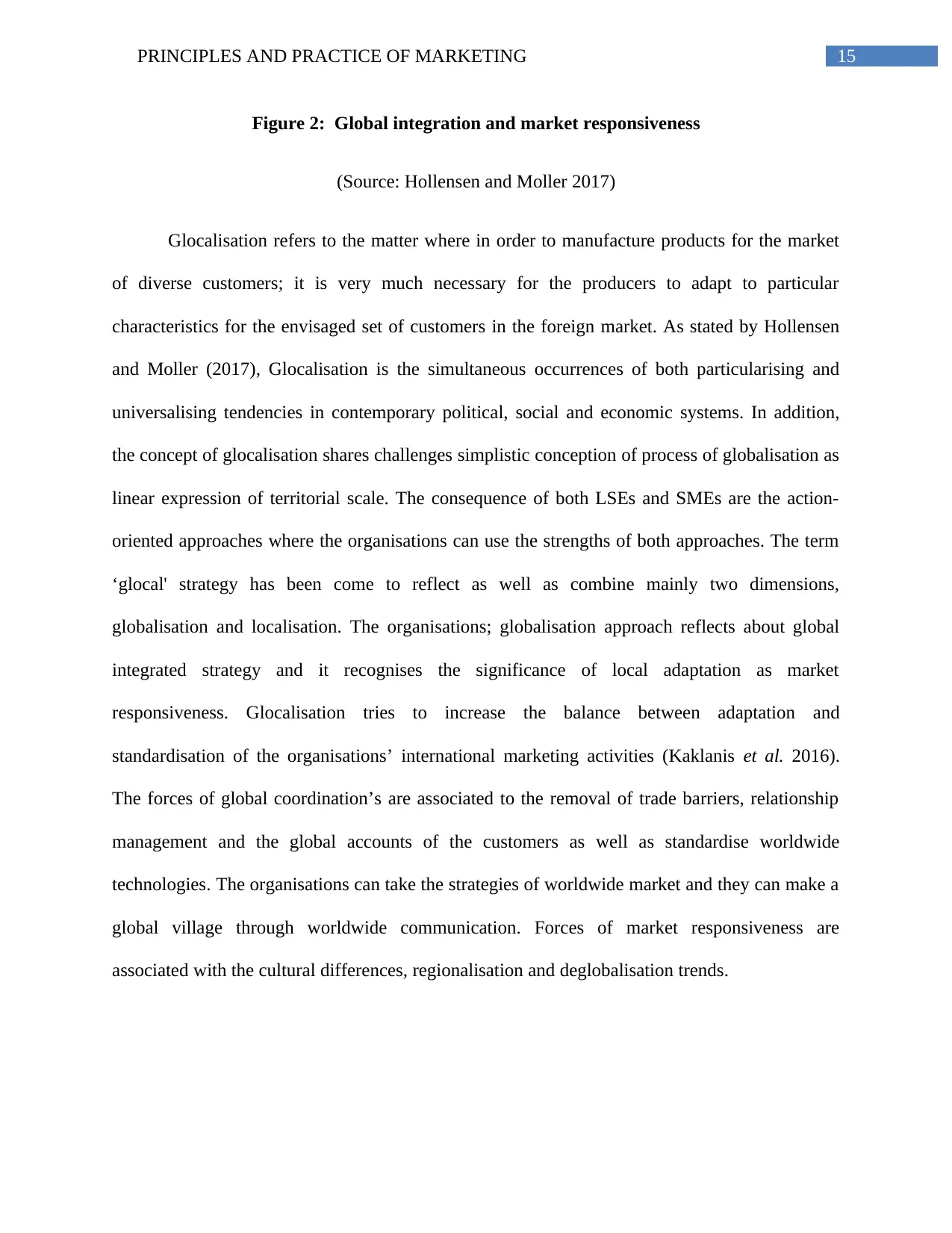
15PRINCIPLES AND PRACTICE OF MARKETING
Figure 2: Global integration and market responsiveness
(Source: Hollensen and Moller 2017)
Glocalisation refers to the matter where in order to manufacture products for the market
of diverse customers; it is very much necessary for the producers to adapt to particular
characteristics for the envisaged set of customers in the foreign market. As stated by Hollensen
and Moller (2017), Glocalisation is the simultaneous occurrences of both particularising and
universalising tendencies in contemporary political, social and economic systems. In addition,
the concept of glocalisation shares challenges simplistic conception of process of globalisation as
linear expression of territorial scale. The consequence of both LSEs and SMEs are the action-
oriented approaches where the organisations can use the strengths of both approaches. The term
‘glocal' strategy has been come to reflect as well as combine mainly two dimensions,
globalisation and localisation. The organisations; globalisation approach reflects about global
integrated strategy and it recognises the significance of local adaptation as market
responsiveness. Glocalisation tries to increase the balance between adaptation and
standardisation of the organisations’ international marketing activities (Kaklanis et al. 2016).
The forces of global coordination’s are associated to the removal of trade barriers, relationship
management and the global accounts of the customers as well as standardise worldwide
technologies. The organisations can take the strategies of worldwide market and they can make a
global village through worldwide communication. Forces of market responsiveness are
associated with the cultural differences, regionalisation and deglobalisation trends.
Figure 2: Global integration and market responsiveness
(Source: Hollensen and Moller 2017)
Glocalisation refers to the matter where in order to manufacture products for the market
of diverse customers; it is very much necessary for the producers to adapt to particular
characteristics for the envisaged set of customers in the foreign market. As stated by Hollensen
and Moller (2017), Glocalisation is the simultaneous occurrences of both particularising and
universalising tendencies in contemporary political, social and economic systems. In addition,
the concept of glocalisation shares challenges simplistic conception of process of globalisation as
linear expression of territorial scale. The consequence of both LSEs and SMEs are the action-
oriented approaches where the organisations can use the strengths of both approaches. The term
‘glocal' strategy has been come to reflect as well as combine mainly two dimensions,
globalisation and localisation. The organisations; globalisation approach reflects about global
integrated strategy and it recognises the significance of local adaptation as market
responsiveness. Glocalisation tries to increase the balance between adaptation and
standardisation of the organisations’ international marketing activities (Kaklanis et al. 2016).
The forces of global coordination’s are associated to the removal of trade barriers, relationship
management and the global accounts of the customers as well as standardise worldwide
technologies. The organisations can take the strategies of worldwide market and they can make a
global village through worldwide communication. Forces of market responsiveness are
associated with the cultural differences, regionalisation and deglobalisation trends.
Secure Best Marks with AI Grader
Need help grading? Try our AI Grader for instant feedback on your assignments.
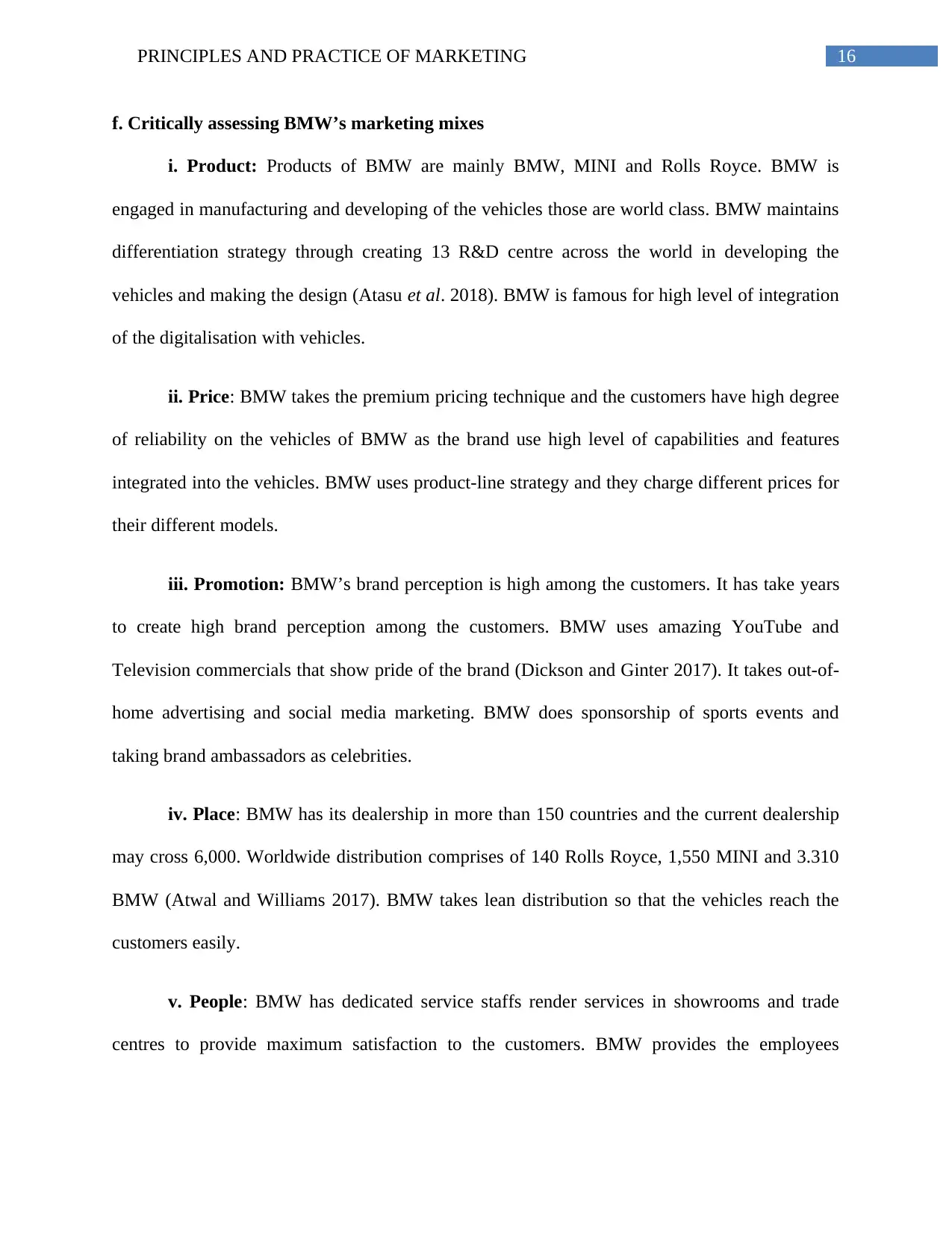
16PRINCIPLES AND PRACTICE OF MARKETING
f. Critically assessing BMW’s marketing mixes
i. Product: Products of BMW are mainly BMW, MINI and Rolls Royce. BMW is
engaged in manufacturing and developing of the vehicles those are world class. BMW maintains
differentiation strategy through creating 13 R&D centre across the world in developing the
vehicles and making the design (Atasu et al. 2018). BMW is famous for high level of integration
of the digitalisation with vehicles.
ii. Price: BMW takes the premium pricing technique and the customers have high degree
of reliability on the vehicles of BMW as the brand use high level of capabilities and features
integrated into the vehicles. BMW uses product-line strategy and they charge different prices for
their different models.
iii. Promotion: BMW’s brand perception is high among the customers. It has take years
to create high brand perception among the customers. BMW uses amazing YouTube and
Television commercials that show pride of the brand (Dickson and Ginter 2017). It takes out-of-
home advertising and social media marketing. BMW does sponsorship of sports events and
taking brand ambassadors as celebrities.
iv. Place: BMW has its dealership in more than 150 countries and the current dealership
may cross 6,000. Worldwide distribution comprises of 140 Rolls Royce, 1,550 MINI and 3.310
BMW (Atwal and Williams 2017). BMW takes lean distribution so that the vehicles reach the
customers easily.
v. People: BMW has dedicated service staffs render services in showrooms and trade
centres to provide maximum satisfaction to the customers. BMW provides the employees
f. Critically assessing BMW’s marketing mixes
i. Product: Products of BMW are mainly BMW, MINI and Rolls Royce. BMW is
engaged in manufacturing and developing of the vehicles those are world class. BMW maintains
differentiation strategy through creating 13 R&D centre across the world in developing the
vehicles and making the design (Atasu et al. 2018). BMW is famous for high level of integration
of the digitalisation with vehicles.
ii. Price: BMW takes the premium pricing technique and the customers have high degree
of reliability on the vehicles of BMW as the brand use high level of capabilities and features
integrated into the vehicles. BMW uses product-line strategy and they charge different prices for
their different models.
iii. Promotion: BMW’s brand perception is high among the customers. It has take years
to create high brand perception among the customers. BMW uses amazing YouTube and
Television commercials that show pride of the brand (Dickson and Ginter 2017). It takes out-of-
home advertising and social media marketing. BMW does sponsorship of sports events and
taking brand ambassadors as celebrities.
iv. Place: BMW has its dealership in more than 150 countries and the current dealership
may cross 6,000. Worldwide distribution comprises of 140 Rolls Royce, 1,550 MINI and 3.310
BMW (Atwal and Williams 2017). BMW takes lean distribution so that the vehicles reach the
customers easily.
v. People: BMW has dedicated service staffs render services in showrooms and trade
centres to provide maximum satisfaction to the customers. BMW provides the employees
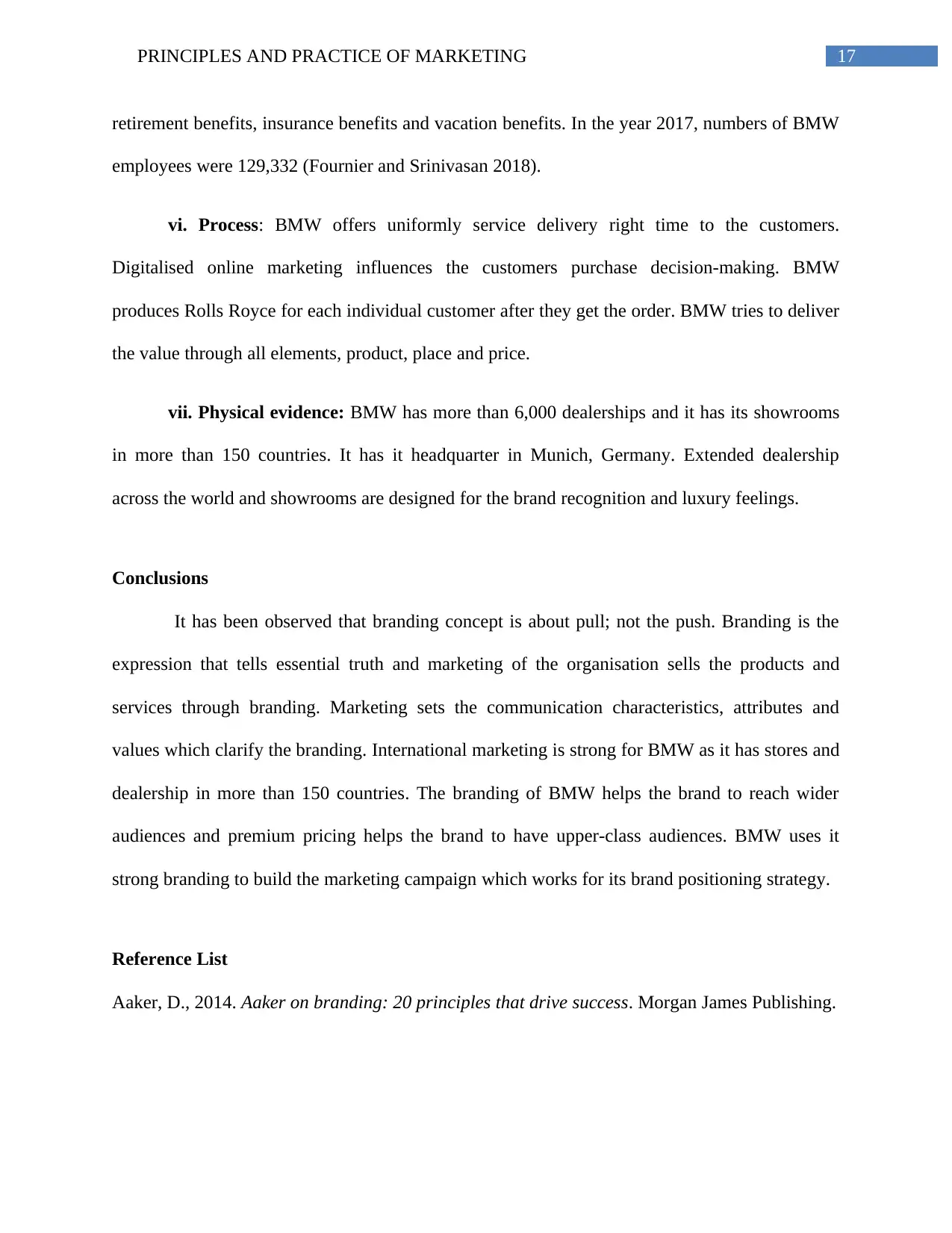
17PRINCIPLES AND PRACTICE OF MARKETING
retirement benefits, insurance benefits and vacation benefits. In the year 2017, numbers of BMW
employees were 129,332 (Fournier and Srinivasan 2018).
vi. Process: BMW offers uniformly service delivery right time to the customers.
Digitalised online marketing influences the customers purchase decision-making. BMW
produces Rolls Royce for each individual customer after they get the order. BMW tries to deliver
the value through all elements, product, place and price.
vii. Physical evidence: BMW has more than 6,000 dealerships and it has its showrooms
in more than 150 countries. It has it headquarter in Munich, Germany. Extended dealership
across the world and showrooms are designed for the brand recognition and luxury feelings.
Conclusions
It has been observed that branding concept is about pull; not the push. Branding is the
expression that tells essential truth and marketing of the organisation sells the products and
services through branding. Marketing sets the communication characteristics, attributes and
values which clarify the branding. International marketing is strong for BMW as it has stores and
dealership in more than 150 countries. The branding of BMW helps the brand to reach wider
audiences and premium pricing helps the brand to have upper-class audiences. BMW uses it
strong branding to build the marketing campaign which works for its brand positioning strategy.
Reference List
Aaker, D., 2014. Aaker on branding: 20 principles that drive success. Morgan James Publishing.
retirement benefits, insurance benefits and vacation benefits. In the year 2017, numbers of BMW
employees were 129,332 (Fournier and Srinivasan 2018).
vi. Process: BMW offers uniformly service delivery right time to the customers.
Digitalised online marketing influences the customers purchase decision-making. BMW
produces Rolls Royce for each individual customer after they get the order. BMW tries to deliver
the value through all elements, product, place and price.
vii. Physical evidence: BMW has more than 6,000 dealerships and it has its showrooms
in more than 150 countries. It has it headquarter in Munich, Germany. Extended dealership
across the world and showrooms are designed for the brand recognition and luxury feelings.
Conclusions
It has been observed that branding concept is about pull; not the push. Branding is the
expression that tells essential truth and marketing of the organisation sells the products and
services through branding. Marketing sets the communication characteristics, attributes and
values which clarify the branding. International marketing is strong for BMW as it has stores and
dealership in more than 150 countries. The branding of BMW helps the brand to reach wider
audiences and premium pricing helps the brand to have upper-class audiences. BMW uses it
strong branding to build the marketing campaign which works for its brand positioning strategy.
Reference List
Aaker, D., 2014. Aaker on branding: 20 principles that drive success. Morgan James Publishing.
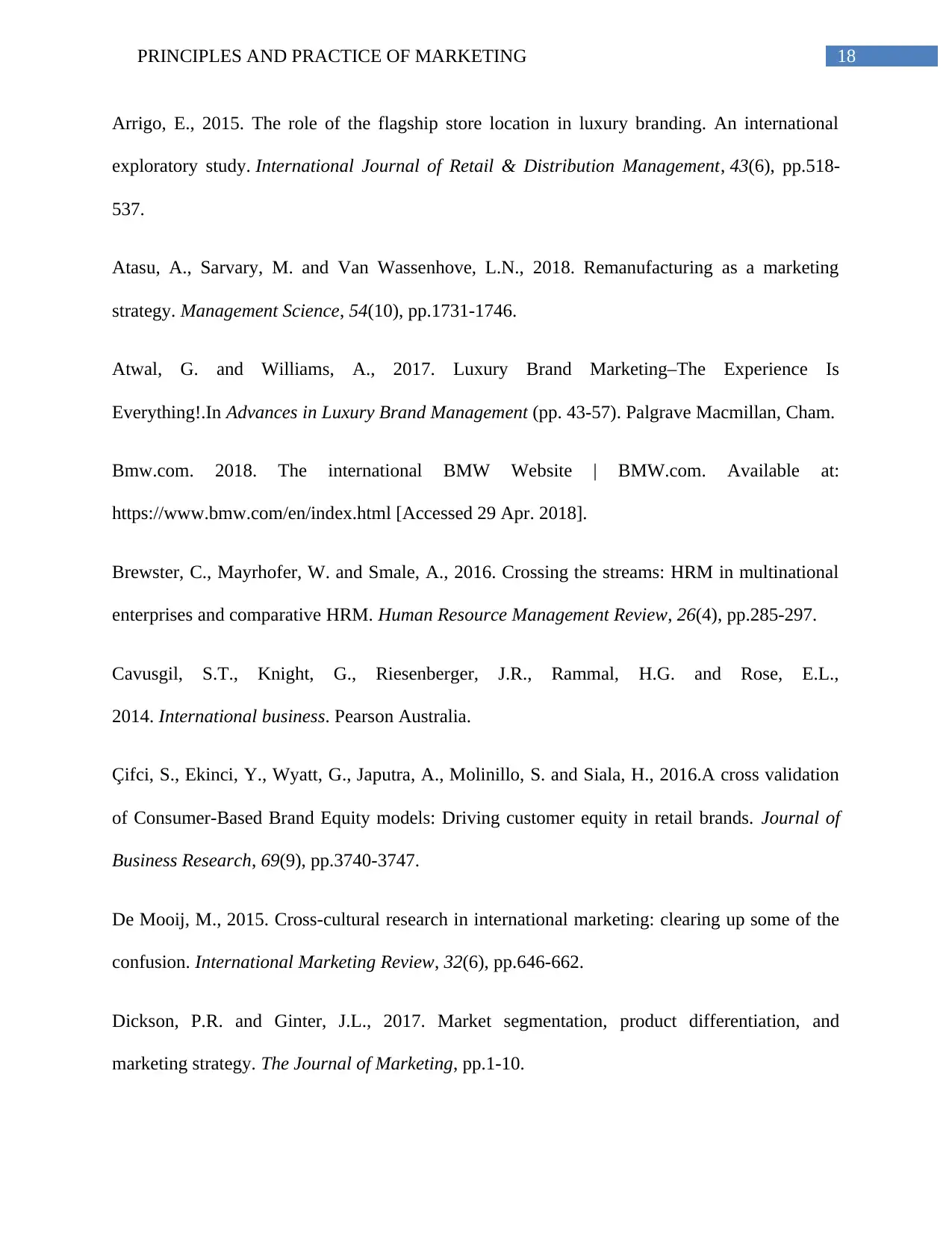
18PRINCIPLES AND PRACTICE OF MARKETING
Arrigo, E., 2015. The role of the flagship store location in luxury branding. An international
exploratory study. International Journal of Retail & Distribution Management, 43(6), pp.518-
537.
Atasu, A., Sarvary, M. and Van Wassenhove, L.N., 2018. Remanufacturing as a marketing
strategy. Management Science, 54(10), pp.1731-1746.
Atwal, G. and Williams, A., 2017. Luxury Brand Marketing–The Experience Is
Everything!.In Advances in Luxury Brand Management (pp. 43-57). Palgrave Macmillan, Cham.
Bmw.com. 2018. The international BMW Website | BMW.com. Available at:
https://www.bmw.com/en/index.html [Accessed 29 Apr. 2018].
Brewster, C., Mayrhofer, W. and Smale, A., 2016. Crossing the streams: HRM in multinational
enterprises and comparative HRM. Human Resource Management Review, 26(4), pp.285-297.
Cavusgil, S.T., Knight, G., Riesenberger, J.R., Rammal, H.G. and Rose, E.L.,
2014. International business. Pearson Australia.
Çifci, S., Ekinci, Y., Wyatt, G., Japutra, A., Molinillo, S. and Siala, H., 2016.A cross validation
of Consumer-Based Brand Equity models: Driving customer equity in retail brands. Journal of
Business Research, 69(9), pp.3740-3747.
De Mooij, M., 2015. Cross-cultural research in international marketing: clearing up some of the
confusion. International Marketing Review, 32(6), pp.646-662.
Dickson, P.R. and Ginter, J.L., 2017. Market segmentation, product differentiation, and
marketing strategy. The Journal of Marketing, pp.1-10.
Arrigo, E., 2015. The role of the flagship store location in luxury branding. An international
exploratory study. International Journal of Retail & Distribution Management, 43(6), pp.518-
537.
Atasu, A., Sarvary, M. and Van Wassenhove, L.N., 2018. Remanufacturing as a marketing
strategy. Management Science, 54(10), pp.1731-1746.
Atwal, G. and Williams, A., 2017. Luxury Brand Marketing–The Experience Is
Everything!.In Advances in Luxury Brand Management (pp. 43-57). Palgrave Macmillan, Cham.
Bmw.com. 2018. The international BMW Website | BMW.com. Available at:
https://www.bmw.com/en/index.html [Accessed 29 Apr. 2018].
Brewster, C., Mayrhofer, W. and Smale, A., 2016. Crossing the streams: HRM in multinational
enterprises and comparative HRM. Human Resource Management Review, 26(4), pp.285-297.
Cavusgil, S.T., Knight, G., Riesenberger, J.R., Rammal, H.G. and Rose, E.L.,
2014. International business. Pearson Australia.
Çifci, S., Ekinci, Y., Wyatt, G., Japutra, A., Molinillo, S. and Siala, H., 2016.A cross validation
of Consumer-Based Brand Equity models: Driving customer equity in retail brands. Journal of
Business Research, 69(9), pp.3740-3747.
De Mooij, M., 2015. Cross-cultural research in international marketing: clearing up some of the
confusion. International Marketing Review, 32(6), pp.646-662.
Dickson, P.R. and Ginter, J.L., 2017. Market segmentation, product differentiation, and
marketing strategy. The Journal of Marketing, pp.1-10.
Paraphrase This Document
Need a fresh take? Get an instant paraphrase of this document with our AI Paraphraser
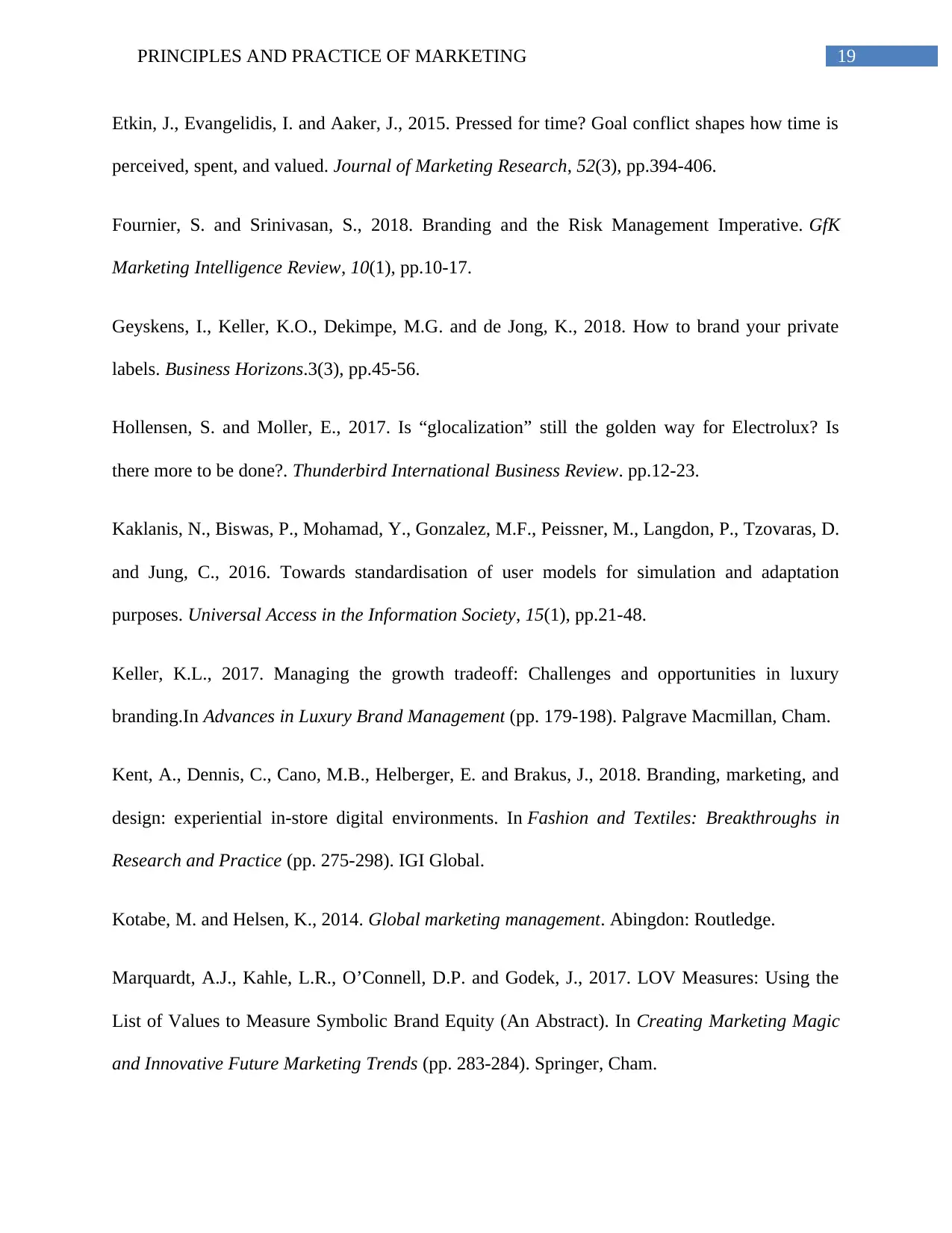
19PRINCIPLES AND PRACTICE OF MARKETING
Etkin, J., Evangelidis, I. and Aaker, J., 2015. Pressed for time? Goal conflict shapes how time is
perceived, spent, and valued. Journal of Marketing Research, 52(3), pp.394-406.
Fournier, S. and Srinivasan, S., 2018. Branding and the Risk Management Imperative. GfK
Marketing Intelligence Review, 10(1), pp.10-17.
Geyskens, I., Keller, K.O., Dekimpe, M.G. and de Jong, K., 2018. How to brand your private
labels. Business Horizons.3(3), pp.45-56.
Hollensen, S. and Moller, E., 2017. Is “glocalization” still the golden way for Electrolux? Is
there more to be done?. Thunderbird International Business Review. pp.12-23.
Kaklanis, N., Biswas, P., Mohamad, Y., Gonzalez, M.F., Peissner, M., Langdon, P., Tzovaras, D.
and Jung, C., 2016. Towards standardisation of user models for simulation and adaptation
purposes. Universal Access in the Information Society, 15(1), pp.21-48.
Keller, K.L., 2017. Managing the growth tradeoff: Challenges and opportunities in luxury
branding.In Advances in Luxury Brand Management (pp. 179-198). Palgrave Macmillan, Cham.
Kent, A., Dennis, C., Cano, M.B., Helberger, E. and Brakus, J., 2018. Branding, marketing, and
design: experiential in-store digital environments. In Fashion and Textiles: Breakthroughs in
Research and Practice (pp. 275-298). IGI Global.
Kotabe, M. and Helsen, K., 2014. Global marketing management. Abingdon: Routledge.
Marquardt, A.J., Kahle, L.R., O’Connell, D.P. and Godek, J., 2017. LOV Measures: Using the
List of Values to Measure Symbolic Brand Equity (An Abstract). In Creating Marketing Magic
and Innovative Future Marketing Trends (pp. 283-284). Springer, Cham.
Etkin, J., Evangelidis, I. and Aaker, J., 2015. Pressed for time? Goal conflict shapes how time is
perceived, spent, and valued. Journal of Marketing Research, 52(3), pp.394-406.
Fournier, S. and Srinivasan, S., 2018. Branding and the Risk Management Imperative. GfK
Marketing Intelligence Review, 10(1), pp.10-17.
Geyskens, I., Keller, K.O., Dekimpe, M.G. and de Jong, K., 2018. How to brand your private
labels. Business Horizons.3(3), pp.45-56.
Hollensen, S. and Moller, E., 2017. Is “glocalization” still the golden way for Electrolux? Is
there more to be done?. Thunderbird International Business Review. pp.12-23.
Kaklanis, N., Biswas, P., Mohamad, Y., Gonzalez, M.F., Peissner, M., Langdon, P., Tzovaras, D.
and Jung, C., 2016. Towards standardisation of user models for simulation and adaptation
purposes. Universal Access in the Information Society, 15(1), pp.21-48.
Keller, K.L., 2017. Managing the growth tradeoff: Challenges and opportunities in luxury
branding.In Advances in Luxury Brand Management (pp. 179-198). Palgrave Macmillan, Cham.
Kent, A., Dennis, C., Cano, M.B., Helberger, E. and Brakus, J., 2018. Branding, marketing, and
design: experiential in-store digital environments. In Fashion and Textiles: Breakthroughs in
Research and Practice (pp. 275-298). IGI Global.
Kotabe, M. and Helsen, K., 2014. Global marketing management. Abingdon: Routledge.
Marquardt, A.J., Kahle, L.R., O’Connell, D.P. and Godek, J., 2017. LOV Measures: Using the
List of Values to Measure Symbolic Brand Equity (An Abstract). In Creating Marketing Magic
and Innovative Future Marketing Trends (pp. 283-284). Springer, Cham.
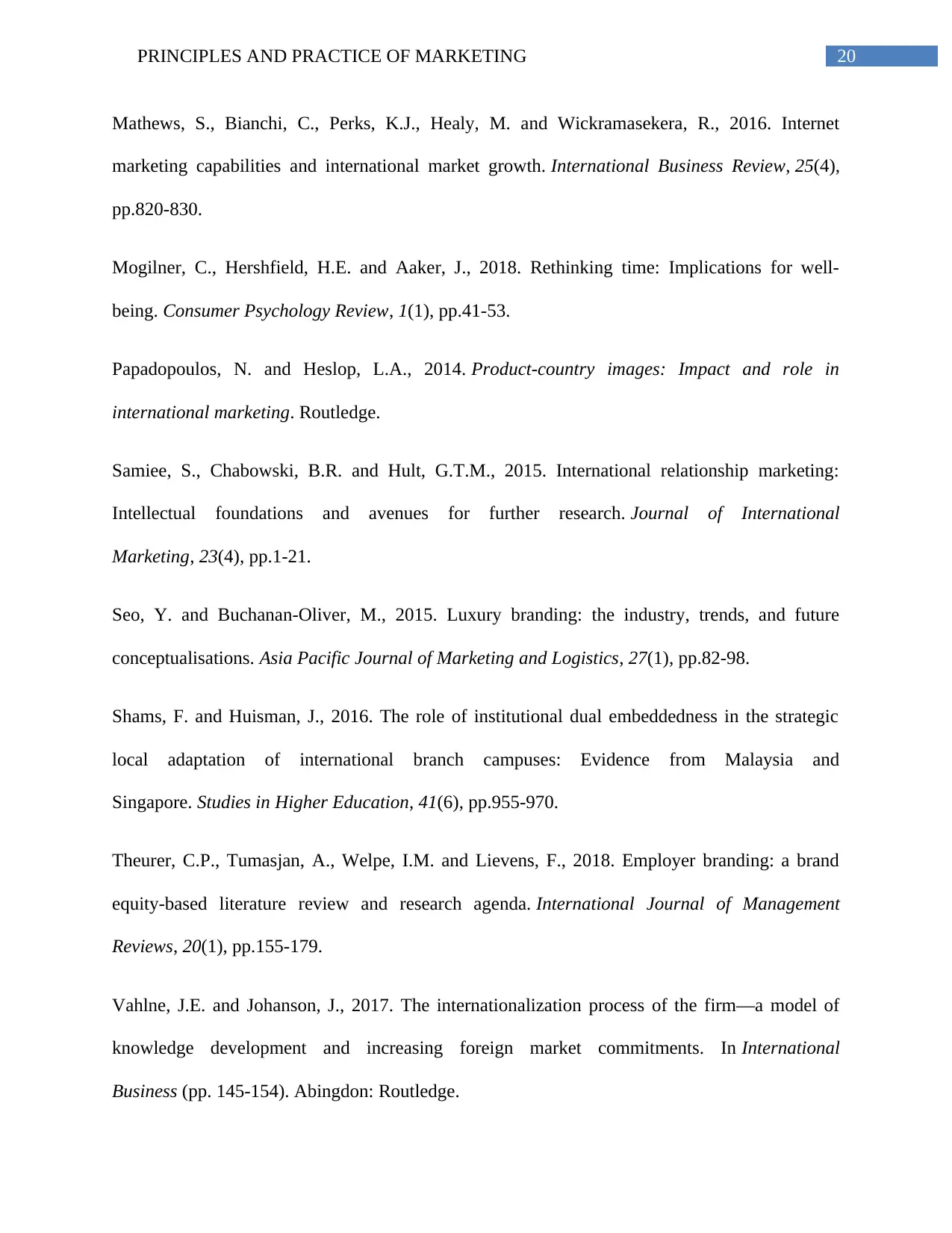
20PRINCIPLES AND PRACTICE OF MARKETING
Mathews, S., Bianchi, C., Perks, K.J., Healy, M. and Wickramasekera, R., 2016. Internet
marketing capabilities and international market growth. International Business Review, 25(4),
pp.820-830.
Mogilner, C., Hershfield, H.E. and Aaker, J., 2018. Rethinking time: Implications for well‐
being. Consumer Psychology Review, 1(1), pp.41-53.
Papadopoulos, N. and Heslop, L.A., 2014. Product-country images: Impact and role in
international marketing. Routledge.
Samiee, S., Chabowski, B.R. and Hult, G.T.M., 2015. International relationship marketing:
Intellectual foundations and avenues for further research. Journal of International
Marketing, 23(4), pp.1-21.
Seo, Y. and Buchanan-Oliver, M., 2015. Luxury branding: the industry, trends, and future
conceptualisations. Asia Pacific Journal of Marketing and Logistics, 27(1), pp.82-98.
Shams, F. and Huisman, J., 2016. The role of institutional dual embeddedness in the strategic
local adaptation of international branch campuses: Evidence from Malaysia and
Singapore. Studies in Higher Education, 41(6), pp.955-970.
Theurer, C.P., Tumasjan, A., Welpe, I.M. and Lievens, F., 2018. Employer branding: a brand
equity‐based literature review and research agenda. International Journal of Management
Reviews, 20(1), pp.155-179.
Vahlne, J.E. and Johanson, J., 2017. The internationalization process of the firm—a model of
knowledge development and increasing foreign market commitments. In International
Business (pp. 145-154). Abingdon: Routledge.
Mathews, S., Bianchi, C., Perks, K.J., Healy, M. and Wickramasekera, R., 2016. Internet
marketing capabilities and international market growth. International Business Review, 25(4),
pp.820-830.
Mogilner, C., Hershfield, H.E. and Aaker, J., 2018. Rethinking time: Implications for well‐
being. Consumer Psychology Review, 1(1), pp.41-53.
Papadopoulos, N. and Heslop, L.A., 2014. Product-country images: Impact and role in
international marketing. Routledge.
Samiee, S., Chabowski, B.R. and Hult, G.T.M., 2015. International relationship marketing:
Intellectual foundations and avenues for further research. Journal of International
Marketing, 23(4), pp.1-21.
Seo, Y. and Buchanan-Oliver, M., 2015. Luxury branding: the industry, trends, and future
conceptualisations. Asia Pacific Journal of Marketing and Logistics, 27(1), pp.82-98.
Shams, F. and Huisman, J., 2016. The role of institutional dual embeddedness in the strategic
local adaptation of international branch campuses: Evidence from Malaysia and
Singapore. Studies in Higher Education, 41(6), pp.955-970.
Theurer, C.P., Tumasjan, A., Welpe, I.M. and Lievens, F., 2018. Employer branding: a brand
equity‐based literature review and research agenda. International Journal of Management
Reviews, 20(1), pp.155-179.
Vahlne, J.E. and Johanson, J., 2017. The internationalization process of the firm—a model of
knowledge development and increasing foreign market commitments. In International
Business (pp. 145-154). Abingdon: Routledge.

21PRINCIPLES AND PRACTICE OF MARKETING
Wild, J.J., Wild, K.L. and Han, J.C., 2014. International business. London: Pearson Education
Limited.
Wild, J.J., Wild, K.L. and Han, J.C., 2014. International business. London: Pearson Education
Limited.
1 out of 22
Related Documents
Your All-in-One AI-Powered Toolkit for Academic Success.
+13062052269
info@desklib.com
Available 24*7 on WhatsApp / Email
![[object Object]](/_next/static/media/star-bottom.7253800d.svg)
Unlock your academic potential
© 2024 | Zucol Services PVT LTD | All rights reserved.





